You can use your computers arrow keys to scroll up and down this page.
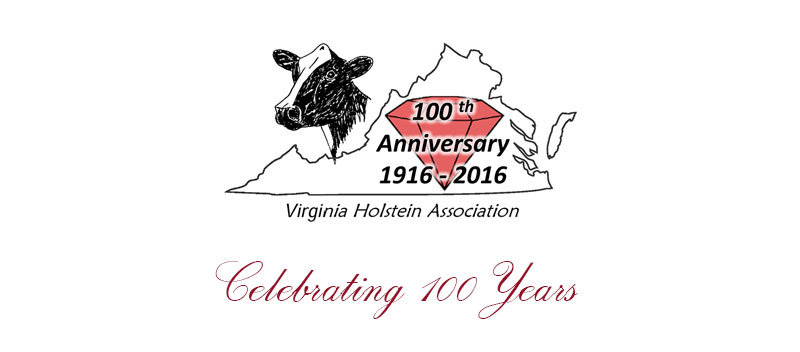
To celebrate the 100th anniversary of the Virginia Holstein Association,
we will be posting stories on this webpage, that will track their history.
Check back frequently to see the new stories that are added.
The newest stories will be added at the bottom of this page.
Happy Anniversary Virginia Holstein Association!
----------------------------
The Newest Information Is Added To The Bottom Of This Webpage
Virginia Holstein Association Celebrates 100 years
-
On February 10, 1916 thirty-two visionary individuals met in Harrisonburg, Virginia and formed the Virginia Holstein-Friesian Club. They wrote and adopted a set of by-laws to govern the organization.
Through the years the group changed their name several times. In 1956 it became the Virginia Holstein Breeders Association and was granted a charter of incorporation. And again in 1969 the name was changed to Virginia Holstein Association Incorporated with new by-laws. Virginia was divided into ten district clubs, each having its own Black and White Show, twilight meetings and officers.
The Virginia Holstein Association has hosted the National Holstein Convention five times through the years—the most recent in 2011. These conventions helped put Virginia and their members on the map for their top notch breeding programs.
The most popular of Virginia breeding was the advent of Round Oak Rag Apple Elevation. His daughters were in high demand all across the United States. He was designated as the “Bull Of the Century” in 2006. A highway marker has been placed near his Virginia birthplace in his honor.
The current Virginia Holstein Association can thank these visionaries for seeing ahead, setting goals, organizing and leading the early group through some trying times.
Virginia Holstein Association and the National Holstein Association Work Together for 100 years
From the early years of the Virginia Holstein Association ( originally , The Virginia Holstein Breeders Association), the membership worked closely with the National Holstein Association. In just 6 short years the Virginia membership numbered 120 National members.
In 1923, a delegation of Holstein members in cooperation with the Richmond Chamber of Commerce went to the National Holstein Convention in Kansas City and extended the invitation for the National Convention to be in Virginia in 1924. The invitation was accepted and held in Richmond June 4, 1924 with the Virginia delegates being Frank S. Walker and J. Scott Parrish. This was the first National Holstein Convention to be held in the south.
The chairman of the convention was Frank S. Walker, of Rosni Holsteins. The sale chairman was W.L. Kirby, Richmond, Va. The sale average on 148 head was $260.00. Ten Virginia breeders consigned 26 head and over 100 head were purchased by Virginia breeders. It was believed that this convention did more to promote Virginia Holsteins than anything else at that time.
From 1930- 1932, Frank S. Walker of Rosni Holsteins served as Vice President of the Holstein- Friesian Association of America and Harold W. Craun , of Wipledale Holsteins served eight years as a National Director from 1957-1969. Harold also served as National Vice-president 1967-1969 and as National President for an additional 2 years, 1969-1971. Also serving as a National Director was Nelson Gardner of Rocby Holsteins from 1981-1989.
In 1952, the 67th National Convention returned to Virginia in the city of Roanoke, with R.G.Connelly serving as convention chairman. The highlight of this convention was the speaker, the Honorable Harry F. Byrd, United States Senator from Virginia. Convention tours were taken to Virginia Polytechnic Institute (now Virginia Tech) in Blacksburg. The sale chairman was Paul M. Reaves. The sale had 90 animals consigned and sold for an average of $1301.00 with 20% staying in Virginia.
In 1962, Virginia once again hosted the 77th National Holstein Convention in Roanoke, Virginia with Harold W. Craun serving as convention chairman. Sale chairman was George A. Miller with the sale being held at Victory Stadium in Roanoke. The sale average on 75 head was $1018.00. It seemed the delegates appreciated the southern hospitality extended by the Virginia breeders and the beautiful scenery of the Blue Ridge Parkway and the Skyline Drive.
The 98th National Holstein Convention returned to Virginia in 1983 and was held on the coast in Norfolk, Virginia. The convention chairman was Hershel Gardner, of Garlee Holsteins. Host day included a visit to Colonel Williamsburg with lunch on the grounds of William and Mary College. The sale was held at Bayville Farm, in Virginia Beach near the Chesapeake Bay Bridge/Tunnel. Serving as sale chairman was Walter V. McClure Sr. of Windswept Holsteins. This sale had the highest average for a National Holstein Convention Sale of $17,861.00
Fast forward to 2011 and Virginia once again hosted the 126th National Holstein Convention in Richmond, Virginia. Serving as Convention Co-Chairman were Barbara Clary and James Cook, of Jareco Holsteins. Sale chairman was Riley F. Wagner, of Rilara Holsteins with the sale located in the air- conditioned Richmond Convention Center. Over 1000 persons enjoyed the presale meal. Holstein World Productions was on hand to broadcast the sale of 113 animals, live on the internet with 8000 viewers world wide. It was during this time that genomic testing became a new tool in animal selection and helped give the sale an average of $14,810.00, the second highest average for National Holstein Convention Sale. Convention tours included local farms, Monticello, Williamsburg, Washington D.C. and Richmond, Virginia.
Early in the relationship of National Association and the State Association, the boards resolved together to obtain a field person to service the south. Through the past 60 years the following persons have served Virginia as it National Regional Holstein Representatives: *
Kelly Barbee
Andrew Bishop
Grayson Bowers
Robert (Bob) Cain
William (Bill) Dawson
Robert Heilman
William (Buddy) Hill
Lukus Hively
Keith Maxey
Bentz Rhoads
Lois Remsburg Skeen
Judy Wolford
Allen N. Crissey
John L. Morris
Lawrence Richter
Thomas Bentley
Donald Burton
Jack Krause
And since 2004, Michael Hendrix of Independence, Virginia has served as field person for all of the Southeastern United States.
Many of these individuals have gone on to be employed in the dairy industry in many positions such as farm managers and owners, Holstein classifiers, show judges and in livestock export.
Virginia Holstein Association and Holstein Association USA will continue to work together because it is a relationship that has benefited everyone involved for 100 years!
*List furnished by Holstein Association USA-earlier representatives unavailable.
ROUND OAK RAG APPLE ELEVATION
1965 - 1979
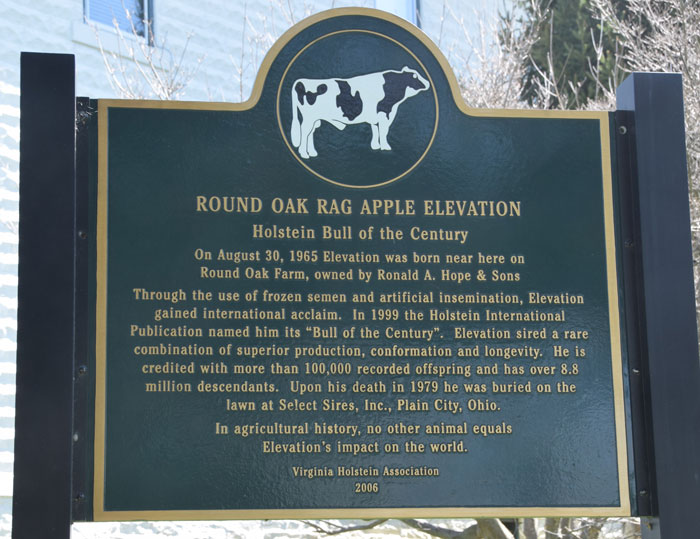
The Highway Marker In His Honor
The Virginia Holstein Association celebrates its 100th Anniversary in 2016 and we look back on the people, events, and registered Holstein animals that have had an impact on not only the state organization but Holsteins across the state, nation, and world. No one Holstein animal can claim the impact worldwide as Round Oak Rag Apple Elevation.
Bred by well-known Holstein breeder Ronald A. Hope, Purcellville, Virginia on August 30, 1965. His dam, Round Oak Ivanhoe Eve (4E-94), “a big, tall, open-ribbed Ivanhoe daughter”. She traces 20 times to Johanna Rag Apple Pabst, founder of the Rag Apple bloodlines. His sire, Tidy Burke Elevation, was an inbred Wis Burke Ideal son tracing 11 times to Wisconsin Admiral Burke Lad, the foundation of the Burke bloodlines.
The magical mating of two inbred Holsteins was the collaboration of Ronald A. Hope and his cousin, George Miller. George was then with Virginia Artificial Breeding Association which later became part of Select Sires, Inc.
July 20, 1966 was a very historic day for Virginia Holstein members. The annual state Holstein Field Day was held at Foxlease Farm, Upperville, Virginia. The featured speaker was Representative Gerald Ford of Michigan. A group of breeders representing VA ABA traveled a few miles away after the day’s program to consider the purchase of a yearling bull, Round Oak Rag Apple Elevation. Never before had the organization paid more than $1,000 for a young sire but finally agreed to settle for a purchase price of $2,800. Who could have predicted that Gerald Ford would become President of the United States and that young yearling bull would become the most influential Holstein bull in the world!
Early sampling of Elevation was done by VA ABA and Sire Power. Virginia breeders were some of the first to recognize the improvement that Elevation daughters made on just normal, average Holstein females. Virginia Holstein sales soon featured Elevation daughters and buyers from all over the U.S. came to buy. In the 1977 California Galaxie Sale the top three selling animals were all Virginia bred Elevation daughters.
It is estimated that over 95% of all Holstein animals worldwide can trace their bloodlines back to Elevation. Several geneticists say it is a very laborious task to find a Holstein without Elevation in their bloodlines. It is estimated that Elevation’s offspring today number close to nine million.
His daughters equally excelled in production and type. Probably most notable was Northcroft Ella Elevation (EX-97) and Brookview Tony Charity (EX-97), a maternal granddaughter.
In 1999 Holstein International named Round Oak Rag Apple Elevation “Bull of the Century”.
In 1974 at the Virginia Sale of Stars, Jimmie Eustace of Willowlyn Farm, Catlett, Virginia consigned Willowlyn Elevation Lou, a senior calf. She was purchased by a young junior Holstein member, Teresa Myers of Walkup Farm, Harrisonburg for $2,050. She was bred to Paclamar Astronaut which resulted in Walkup Astronaut Lou Ann (4E-94-GMD-DOM). “Lou Ann” produced many great daughters with two of the most notable being Walkup Valiant Lou Ella (EX-92-GMD, DOM) and Walkup Bell Lou Etta (VG-88-GMD, DOM). “Lou Ella” became the dam of Rothrock Tradition Leadman and “Lou Etta”, a Rotate daughter, became the dam of Europe’s Etazon Lord Lily ET. “Lou Ann” was the third highest ranking female in Holstein International’s Cows of the Century” recognition contest.
The majority of the twenty-six Holstein cows nominated in the Virginia Holstein Association’s “Cows of the Century” contest can trace their bloodlines back to Elevation, with one being Elevation’s dam.
Elevation put it all together in one package: type, production, good feet and legs, udders, ability to transmit, longevity, and marketing demand for offspring. Some of Elevation’s notable “firsts”:
He was the first Holstein sire to have 10,000 registered sons and the first to have over 600 sons in A.I. Some of his most notable sons include: Starbuck, Tradition, Mars Tony (Virginia bred), Elevation Mars, Bova, and Sexation. For many years his son, Hanoverhill Starbuck was the leading sires of All Americans.
In 1984 he had 54,843 daughters on test, a record at that time for any sire worldwide.
As of March 1, 1982 he had 1000 registered daughters in the 1000 pound fat bracket on DHI test.
By 1982 he had over 200 daughters that had achieved 30,000 pounds of milk in one lactation of 365 days or less.
As of November 1984 he had sired 2862 Excellent daughters.
Of Elevation’s top 100 selling Holstein offspring 49 were sold in 1977 and his top 100 selling offspring by 1977 averaged $11,402.
Today it is estimated that Elevation has over 100,000 registered Holstein worldwide.
From 1977 to 1983 he had 89 All American nominations.
Elevation was exhibited as a bull calf in the 50th Anniversary Virginia Spring Holstein Show and placed second in his class.
In 2006 Holstein members from Virginia and neighboring states gathered back in Loudoun County, Virginia (Ronald Hope’s home) to participate in the “Elevation Celebration”. One of the highlights of the day was the unveiling of an historical roadside marker to honor Elevation. It is believed to be the only such marker in the country honoring a dairy bull.
Virginia Cows of the Century
CLICK HERE to download a pdf of the 7 cows and their profiles named as Cows of the Century in Virginia as part of our 100th anniversary celebration.
CLICK HERE to View the vaholsteins.org web page
You can read all the profiles of the 26 cows nominated.
Celebrating its 100th Anniversary in 2016 the Virginia Holstein
Association conducted the Cows of the Century Contest.
Twenty-six cows that were bred by Virginia breeders carrying
their prefix were nominated. Current members of the Association
were eligible to vote for their top seven cows and after the
final ballots were tallied only one farm/prefix were allowed in
the final top seven Cows of the Century. The cow profiles were
provided by Walter S. McClure, Sr. and are presented in alphabetical
order.
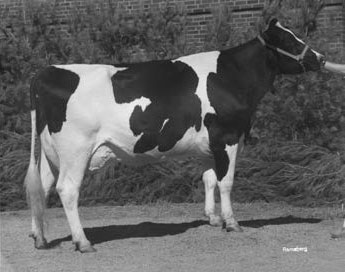
Brookfield Elevation Pretty 3E- 94 DOM
Born 1/11/75 9058489
Pretty was bred by Bill Harrison and developed by Larry and
Wayne Kibler. Pretty, sired by Elevation, was out of an Excellent
Matt daughter, a combination that produced a lot of outstanding
daughters. Pretty was purchased by Larry Kibler in 1979 just
at the time when embryo transplant work was advancing. Larry
flushed her, getting 25 daughters with the Ken Wan prefix before
selling her to Dreamstreet Farm in New York where she
produced 18 more daughters with the Dreamstreet prefix. During
her lifetime, Pretty had 40 classified daughters – 7 EX, 19
VG, 9 G+ and 1 Fair. Pretty was Grand Champion of numerous
Virginia Holstein Shows and many state fairs. Bill sold part of
his herd in the early sixties to Bill Blalock which became the
foundation of the Park Forest Herd.
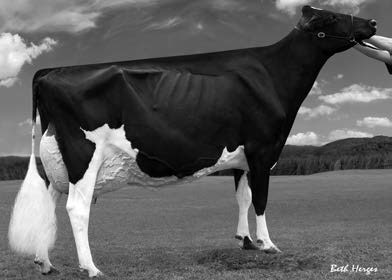
Harvue Roy Frosty 3E- 97 GMD
Born 11/7/02 52378753
Harvue Roy Frosty, scored 3E- 97, is one of the greatest show
cows of the last decade. Frosty is sired by Roy and out of an EX
93 DOM granddaughter of Skybuck, whose VG 88 dam is a VG
Virginia Holstein’s Cows of the Century
86 GMD DOM Bell daughter. Frosty is the very best of many
high scoring cows bred and developed by Harvue. I was amazed
at her strength and dairyness when she was first place three year
old at Madison. Frosty’s show record includes All World 2010
Holstein International, Supreme Champion World Dairy Expo
2010, All-American Aged Cow 2010, Unanimous All-American
Five Year Old 2009, Unanimous Canadian All-American Five
Year Old 2009, Supreme Champion World Dairy Expo 2009,
First Five Year Old, Royal Winter Fair, All-American Sr. Three
Year Old 2007, Sr. and Grand Champion 2007 International
Show, and nominated All-American Sr. 2 Year Old 2006. Her
current milk record is 5 yrs 7 mos 2x 365 days 44,710 milk
5.0% 2222 fat 3.0% 1332 protein. She now has 10 Excellent
daughters and 18 Very Good daughters. The Frosty story is just
beginning to unfold as she is the youngest member of the cows
for Virginia Cow of the Century.
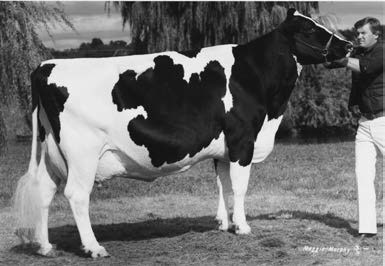
JPG Standout Kandy 2E- 96 GMD
Born 9/30/71 8085585
JPG stands for John P. Garber who is a son-in-law of H. Ralph
Fields, Centerfield Farm. John was herdsmen at Centerfield and
owned a small herd within the Centerfield herd. John called
George Miller at Virginia Animal Breeders to discuss breeding
Kandy’s dam. After a lengthy discussion it was decided to use
Sunnyside Standout. I was going to Loudoun County the next
day so I agreed to take 5 units to John. When I arrived, the cow
was in heat and John bred her that evening resulting in Kandy.
I followed Kandy as she developed. At that time, I was assisting
Horace Backus selecting cows for National sales. We tried
unsuccessfully to have her consigned to the 1976 PA convention
sale. The next year the sale was in Ohio and John finally agreed
to consign her. Kandy topped the sale at $41,000.00 going to Pete
Heffering of Hanover Hills, where she went on to be three times
All-American Aged Cow and twice Reserve All-American Aged
Cow. Kandy was ranked 4th All Time All-American Aged cow in
1984 behind Northcroft Ella Elevation EX 97, Harborcrest Rose
Milly EX 97 and Gene Acres Felicia Mae EX 97. Kandy had two
excellent daughters and one at VG 89. Center-Field Knight Kandy
EX 90 sold in the 1979 Windswept Dispersal for $18,000.00
purchased by Bear Path Farm in NY.
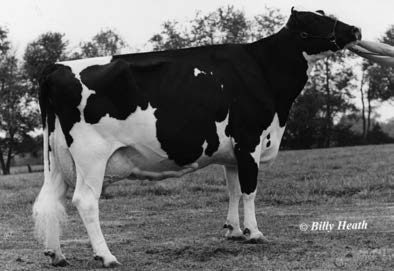
Pottsdale Flip Kamille 4E- 95
Born 6/10/95 15812163
Flip was first place summer yearling and was not shown again
until she was a five year old in 2000 where she was Reserve
Grand Champion and Best Udder of the show. Her dam Pottsdale
Mandingo Kamilah scored 4E- 92 at 18 years and produced
313,234 milk lifetime. Flip’s granddam was Pottsdale Bell Kandy
2E-91 X Pottsdale Mars Katrina VG 88 DOM X Pottsdale
Cinnemon Karla VG 85 GMD DOM X Patson Royal Kingpin
VG 86. Flip was sired by Cook Farm Starbuck Flip. Flip daughters
included Pottsdale Durham Kallie EX 90 and two VG Leduc
daughters. Kallie had excellent daughters by Lou and Encore.
This is the maternal line that continues to impact the Pottsdale
herd today. Flip’s daughter Pottsdale Encore Kandy EX 92 was
sold to Bulldog Holsteins and was Reserve Grand Champion
at the 2004 Maryland Spring Show. She was later sold to FDB
Holsteins, Escalon CA where she was Reserve All-California
in 2005. Another sister was EX 91 and a third sister Pottsdale
Wistar Krista 3E-90 sold to Walkup Holsteins. However, Flip
was not through as a show cow winning Grand Champion, Best
Udder, Best Bred and Owned as a nine year old in the 2004 VA
Summer Show. She was last classified in 2007 going 4E- 95. She
impressed the classifiers with her style, dairy strength and youthful
appearance. Flip lived seventeen years producing 170,292
M 6494 F 5460P lifetime. Pottsdale is the prefix of Dogwood
Farms operated by Mike and Nancy Potts and their family. They
are the only dairy herd left in Loudon County.
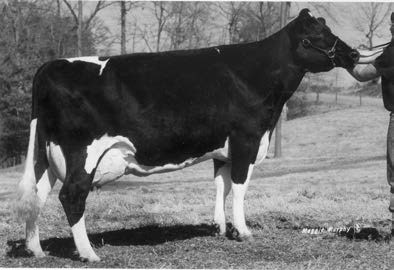
Rilara Mars Las Ravena EX 91 GMD DOM
Born 8/5/79 10183316
Ravena was consigned as a bred heifer to the Southeast Show
Window Sale held in North Carolina in 1981, and was purchased
by Alan Johnson, Hamptonville NC. Alan developed her,
flushed her (over 100 embryos) and when she was in her prime
EX 91 sold her as a feature in the South Fork Sale in Texas hosted
by Price’s Dairy. I attended the sale with Nelson Gardner and
we watched her sell for $225,000.00 to Mike Rainey in Georgia.
Mike put her in a very intense flush schedule and over the
next years he registered 168 animals out of Ravena and exported
over 100 embryos. Ravena and her dam Las were recognized in
1993 as Super Donors for having over 200 registered offspring.
Ravena has been on the cover of the Holstein World, Southeastern
Holstein News and featured in the Holstein International and
the Veeteelt, a Holstein publication in the Netherlands. One of
Ravena’s most famous daughter was Briarpatch- R Misty EX
GMD DOM sired by Thonyma Secret. This is the family that
produced CMV Mica-ET, a popular bull at ABS. Ravena and
Misty’s family were featured in the Holstein Hot Spots in 2012.
Ravena has offspring in over 27 states, the countries of Canada,
Germany, Netherlands, France, Italy, Japan and South Africa.
This is a cow family that continues to leave its impact on the
Holstein breed. The top TPI bull in the breed Seagull Bay Supersire–
ET goes back to Ravena and a full brother Headliner
will have proofs out in August ’15, both being at Select Sires.
They go back to the Misty cow. Ravena was sired by Marshfield
Elevation Tony out of Rilara Haven Charming Las-TW.
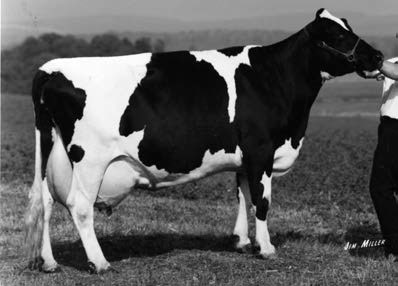
Round Oak Ivanhoe Eve 4E-94
Born 7/14/1962 6749578
Dam of Elevation. When Eve was born I was working as Extension
Dairy Agent in Loudoun County. Eve was sired by Osborndale
Ivanhoe who was quickly becoming the most exciting
bull in the Holstein industry. Over the next few years I watched
her develop into a tremendous cow both in production and type.
She produced a maternal line 6 generations of excellent dams.
Eve’s son, sired by Tidy Burke Elevation, Round Oak Rag Apple
Elevation EX 96 Gold Medal was born on 8/30/1965. I left Loudoun
County to work for Virginia Animal Breeders Association
in 1966 and followed the Round Oak herd in my new duties as
sales manager for the VABA. I was visiting with Ronald Hope
in early July of 1966 and Ronald took me to see Elevation who
was tied up in preparation for the upcoming show season. Ronald
stated that we needed to purchase this bull calf for the stud. On
the following Monday, I visited with George Miller, Manager
of VABA. George was aware of Elevation as he had convinced
Ronald to mate Tidy Burke Elevation to Eve, resulting in Elevation.
George stated that he and Ronald could not make a deal and
told me it was okay for me to contact the VABA Holstein Sire
committee concerning Elevation. The committee agreed to go to
Round Oak after the Holstein Field day on July 19, 1966 held
at neighboring Foxlease Farm managed by Ted Haberland. The
Committee, composed of Chairman Jack Hunt, Harold Craun,
Leonard Crowgey, G.E. Fisher, Doug Child, George Miller and
me, traveled to Round Oak to look at Elevation. Ronald priced
Elevation for $3,000.00 which was more than VABA had ever
paid for a Virginia bred bull. The committee visited and instructed
George to make an offer to Ronald. George came back and stated
that Ronald agreed to sell Elevation to VABA for $2,800.00 but
he would retain him until after the Eastern National Show. Elevation
had a new home at VABA – later a part of Select Sires.
Elevation had two full sisters that scored Excellent but Elevation
was her only offspring that made a significant contribution to the
breed. Eve’s lifetime production was 196,030 M 4.1% 8,070 Fat.
Eve sold in Round Oaks first sale March 5, 1970 before Elevation
was well known to Calvin Will of PA for $11,000.00. The
influence of Elevation “Bull of the Century” has resulted in his
being in the pedigree of over 90% of recent Holstein bulls in almost
every major dairy country worldwide as reported by AIPL
USDA Interbull Bulletin, Volume 33, Page 93. Elevation…”The
Holstein Bull of the Century, and his dam Round Oak Elevation
Eve.”
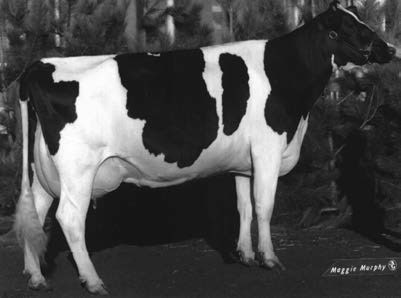
Walkup Astronaut Lou Ann 4E- 94 GMD DOM
Born 1/19/1976 9174127
Willowlyn Elevation Lou EX 91, the dam of Lou Ann, was
the purchase of Walkup Holsteins and Teresa Myers in the 1974
Virginia Sale of Stars for $2,025.00 at approximately 6 months
of age. Lou was bred to Paclamar Astronaut and Walkup
Astronaut Lou Ann was born on January 19, 1976. Lou Ann
developed into one of the most famous cows in the World. Lou
Ann, always showed as a Junior entry by Teresa, was nominated
six times as Jr. All-American. She was named Jr. All- American
as Jr. Yearling, 2 yr old, 3 yr old, twice Reserve All-American
as an Aged Cow and High Honorable as a 4 yr old. Lou Ann
was 4 times Grand Champion at the Virginia State Show. Lou
Ann developed into an outstanding brood cow producing female
offspring that were in high demand. Her Bell daughter Walkup
Bell Lou Etta was a feature of the 1986 Exclusive V Sale bringing
$11,000.00 purchased by Tom Piersiak in Maine where she
wasVG-88 GMD. At High-Sights she had 1 EX, 13 VG, and 3
G+ daughters. A Rotate daughter produced the highly proven
Etazon Lord Lilly bull. Lou Etta daughters produced many proven
A.I. sires. Lou Ann’s most famous daughter, Walkup Valiant
Lou Ella EX 92 GMD DOM, was a feature of the 1983 National
Holstein Convention Sale in Norfolk, VA selling as a bred heifer
for $33,000.00 to Rothrock. Lou Ella had 89 calves at Rothrock;
44 were females, 3 EX (EX 94,EX 93,EX90), 16 VG, 14 G+, 4
Good , 1 Fair and 7 never classified. Four daughters were Gold
Medal Dams. Lou Etta sons were popular in A.I. with 3 earning
Gold Medals. Six sons exported to Japan, 2 sons to Puerto Rico,
7 sons to Canada and at least 8 to US A.I. studs. Walkup Astronaut
Lou Ann’s influence worldwide made her one of the most
famous cows of the last century. Lou Ann’s legacy through her
daughters on the international scene produced the sires Leadman
in the United States, Lord Lily and Canvas in Holland, Mascol
in Germany and Restell in France. All of this contributed to Lou
Ann’s lasting global influence, resulting in her being named the
Third Highest Ranking Female in Holstein International’s Cows
of the Century.
Virginia Holstein’s Cows of the Century
100th Anniversary Powerpoint
During the 100th Anniversary Banquet a powerpoint is being
prepared by Carol McComb to highlight the Virginia Holstein
Association throughout the past 100 years. This can only be
accomplished with the help of its members. If you have photographs
that you would like to be included in the powerpoint
contact Carol to either scan a high quality version and send to
her, or send the photo directly to her to have scanned in.
We are looking forward to the walk down memory lane celebrating
the accomplishments from the past 100 years, so be
sure to contribute to this special event. Carol can be reached by
phone (540-338-6113), mail (19701 Silcott Springs Road, Purcellville,
VA 20132) or email (grandmamccomb@gmail.com).
Holsteins And A Beatle
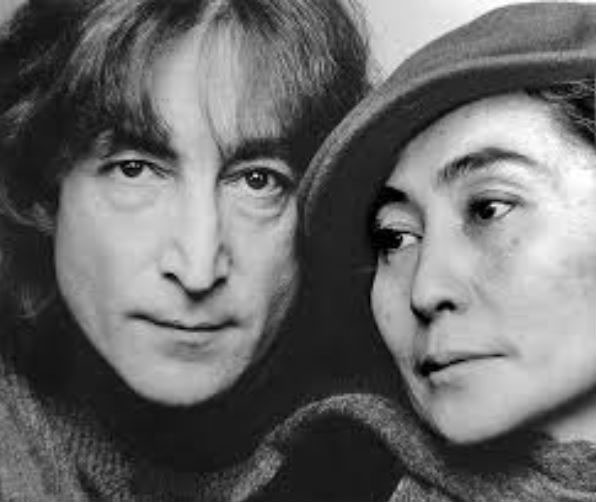
John and Yoko Lennon
--------------------------------
By Dale Gardner
It was an out-of- the- blue call, totally unexpected and the kind of call that would have been easy to dismiss. It was ten o’clock on a fall night in 1978 and an attorney from Lexington, Virginia had just called to inquire if the Rocby Holsteins herd was for sale.
Initially we dismissed the whole idea of selling our herd as ludicrous; it was one thing to sell a few animals to a registered breeder but to sell an entire herd, especially to a lawyer we had never heard of, was an entirely different matter. The sale of the herd would effectively put us out of the dairy business and ,at the time, that seemed out of the question .Despite our skepticism and reluctance, and after a lot of back-and- forth, we decided it wouldn’t cost anything to at least explore this seemingly bizarre opportunity. So, we seriously started the process and from there things became even more bizarre.
We eventually came to terms and agreed to a deal to sell the Rocby herd. It was obvious at this point that the lawyer was just an agent for an undisclosed buyer but we had no idea who the buyer was. It was not until a family Christmas dinner that dad came in and announced we had just sold our herd to John and Yoko Lennon. It was surreal, exciting, and to say we were in total shock would be an understatement. Right place, right time, part luck with a mix of reputation; whatever it was changed things for us from that point forward.
Dad went to New York City and met with Yoko Lennon in Manhattan at the Dakota East Building where she, John and their son lived on the entire 6th floor of the building. Dad never met John Lennon because on that day John and his son happened to be in Central Park on an outing. I remember dad making the comment when he returned from New York that Yoko did not look as good as she looked in the photos, and if you recall, her photos were not that flattering. The spring of the next year, I believe it was March, John was gunned down outside of his building by a crazed fan, John Hinckley.
After news of the sale, the national media picked up the story and dad was invited to go on Good Morning America to discuss the deal. Good Morning America also requested he wear bib overalls to look like a “real farmer.” Due to a non-disclosure agreement he declined the invitation, but I seriously doubt he would have worn bib overalls had he appeared on the show.
A few other interesting tidbits:
On one occasion a stranger walked up to dad and called him a communist because we had sold our cows to John Lennon. John Lennon maybe/probably was a Marxist [a very rich one] but he paid in American dollars.
One morning my wife, Joan, heard a knock on our door and found a stranger asking her to please take a letter to John Lennon. He stated he knew John and that John would want to get in touch with him. Needless to say, she did not take the letter from him.
There were also several phone calls from people convinced that we had access to John Lennon; one from a songwriter who wanted John to sing his songs.
Although we sold the herd, we continued to milk and manage the herd for several years afterward and we never had to go out of business. To this day, it’s still hard to believe something of this nature would happen to a small registered Holstein farm in Bridgewater, Virginia. What at first appeared to be an off- the-wall absurd offer turned out to be a life-changing event. The lesson learned from this event: Always be prepared for opportunity, and be ready to take advantage when it presents itself because the window of opportunity can quickly close.
Virginia Holstein Field Day---A Time Honored Tradition
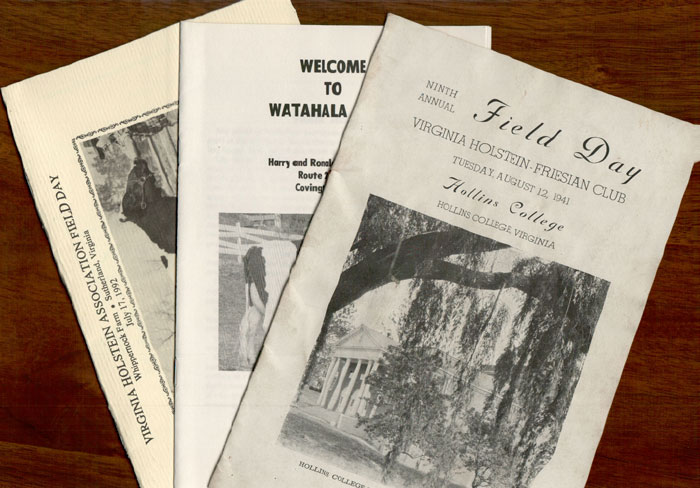
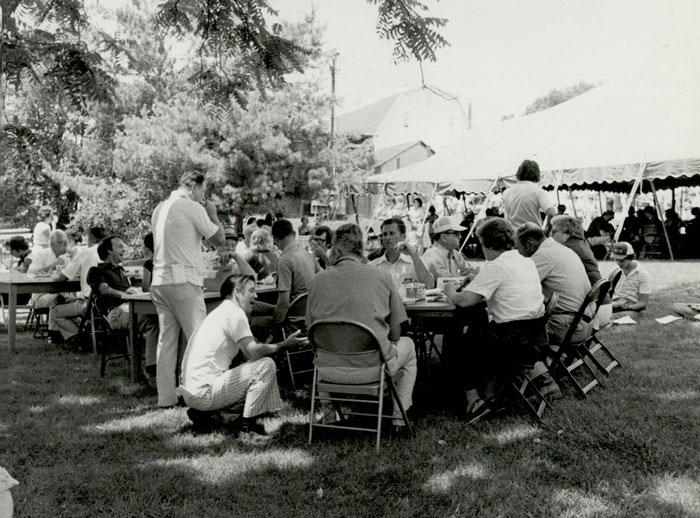
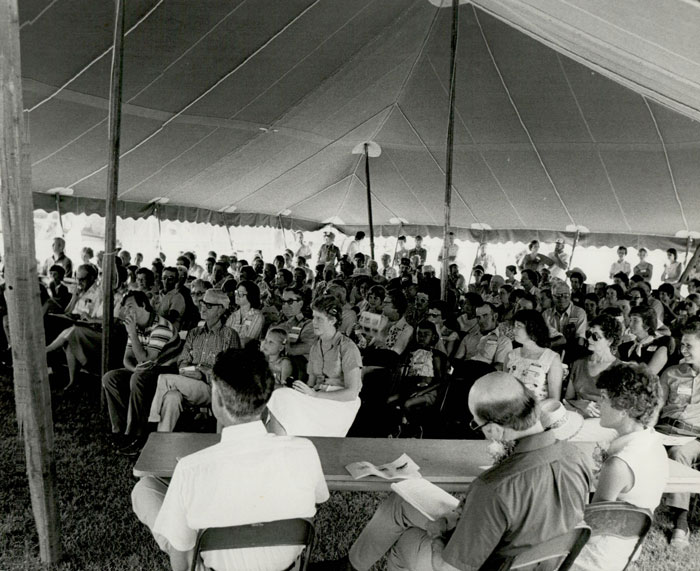
As soon as the farm crops were in the ground and the first cutting of hay was safely stored in the barn, the Holstein community looked forward to their annual “Field Day”. For many this was the social event of the year!
Because it was an all-day affair, the earliest field days included a packed basket lunch provided by the farm families attending. In later years, the noon meal was furnished by the hosting farm. As the cost of the meals increased it became necessary to obtain sponsors for the meal.
To give everyone a chance to attend, the location has always been moved around the state. The day would begin with a rousing welcome from the host family. A program of speakers and dignitaries filled the day followed by entertainment. In early printed programs, the welcome was listed at 10:00 AM with a speaker every one half hour or so. A lunch break was at 12:00-1:00 and then the program continued until 3:00PM. Viewing the cows came before the program and before departing for home. It seemed no one was in a hurry to go home as the “Virginia Holstein Field Day” was the happening of the summer.
The hosting farm prepared a booklet*** outlining the farm’s history. Sometimes describing their colonial home or telling of past ancestors who sacrificed so much. In describing their ancestors you could tell that they were quite proud of their hard working forefathers for making dairy farming their occupation and passing that love on to them.
Many times the supporting employees were recognized for their years of continued service, listing their jobs, and length of employment. Feeding rations were described in great detail including the acreage of crops, types of hay, corn etc. Some even described the type of soil that they had to work with.
Cow pedigrees were of interest and printed, followed by their milk records. Pictures were included and not all of them were professionally taken. It was interesting to note that all farms had a herd bull of which they were quite proud, before the introduction of artificial insemination.
Some of these early field days were planned by the local Holstein clubs with an area farmer providing the location. Today the local Holsteins clubs still assist the farmer hosting by helping to prepare the site by setting up tents, parking and the cleanup.
Farms with new buildings or concepts were and still are favorites to host the field day. Curiosity always seemed to bring out good crowd.
The district clubs, at one time, also held a Twilight meeting during the summer. These meetings were held at local farms with everyone bringing a covered dish with meats usually furnished by the club. The only district club still having the Twilight picnic is the Shenandoah Valley Holstein Club.
**** Many of the Old Field Day booklets will be in the Archive display on November 18.
Harvue Farm To Host Virginia Holstein Field Day And Ag Expo On July 15
As the Virginia Holstein Association celebrates our 100th anniversary we recognize many breeders, farm families, and leaders that have been a significant part of the development and successes of our Association and our industry over the last century. The Hardesty family has played an active role in Virginia Holstein activities for four generations. They are hosting the Field Day and Ag Expo this summer. David Hardesty reflects on the history of Harvue Farms, and how though many things have changed, some goals and ideals have remained the same through the years.
On behalf of the entire Hardesty family we invite you to the 2016 Virginia Holstein Field Day to be held at Harvue Farms on Friday July 15. We will be celebrating the 100th year of the Virginia Holstein Association and hope to have a lot of fellowship during this day. There will be vendor exhibits, special displays to reflect on our past, activities for the kids, and we will view the herd at 11:00.
Harvue was established in 1949 by my father, Jack, and grandfather, John O. Hardesty. They started with 23 cows on 272 acres and shipped their first load of milk on March 1, 1950 to Md-VA Milk Producers. Sixty-six years later we are still shipping milk to Md-VA. We are currently milking 340 cows on 800 acres. In 2009 we built a barn for weaned calves. Two years ago we remodeled our bedded pack barn, added a new one next to it, and built a new concrete manure storage system. About a third of the herd is housed in the pack barns; the rest are housed in free stalls bedded with sand.
My grandfather passed when I was young in 1971. He was a great lover of the Holstein cow and loved the people that were part of the Holstein industry. His appreciation for the value of the relationships we form with other breeders and dairymen has passed down through the generations. We have always stayed involved in the Virginia state sales and shows and have formed lasting friendships because of this opportunity. My brother Johnny and I grew up working on the farm and showing and judging. As we got older I took care of the cows and Johnny looked after the cropping. Johnny was quite a salesman and began our merchandising program. We were fortunate to be friends and neighbors of the Hope family who bred Elevation, and used him quite heavily in the early years. In the first Virginia Sale of Stars in the 1970s we sold an Elevation daughter, Harvue Elevation Eval, that went to Joe Duarte’s farm in California. She made four records over 30,000 there, which was unheard of at that time. This really opened up our merchandising program. Over the next twenty years Johnny traveled out west several times and we sold cattle all over the US and to 20 different countries.
We have always stressed a balance of good production and high type, with particular emphasis on breeding for good udders, feet and legs. To date we have bred over 400 Excellent cows. The best known is Harvue Roy Frosty EX-97 and two time WDE Supreme Champion. We have continued to develop Frosty’s family here at Harvue. Her first two granddaughters scored EX-93 as four year olds.
In 2009 and 2010 our sons Dan and Matt graduated college and came back to the farm. This enabled us to do a much better job in all areas of managing the farm. Thanks to their hard work we developed a surplus of animals and on March 31, 2014 we hosted the Harvue Select Sale. 100 animals averaged $5,000 and sold to eight different states and Canada. We really appreciated the support of our fellow Holstein breeders and friends on that day. Two weeks later my father Jack passed away after a long battle with cancer.
My Dad taught us all a lot about life. The keys were to respect and love your fellow man, even if you don’t always agree with him. He always said it is okay to disagree, but disagree respectfully. One of his other famous quotes was “you never get a second chance to make a first impression so keep your place clean and neat”. We miss my mom and dad dearly and hope to continue their values at Harvue.
Harvue is now operated by myself and my wife, Debbie, and our son Matt and his wife Ashley. Danny is now a full time firefighter and helps us out part time. Danny works closely with Daisy McDonald, who has been our bookkeeper for about 30 years, to keep all the financial records. Matt and Ashley manage the breeding, vaccinating, and general care of the cows and young stock. They also are in charge of showing and advertising. Ralph Orndoff , who has worked here for 36 years, looks after a lot of the crop work and maintains our equipment. Ralph and I do most of the feeding. Neil Barb has been with us 29 years. He does the feeding and looks after things on the night shift. I oversee the cropping operation, do feed purchasing and the financial management. Deb tries to keep us all straight.
We really appreciate our family and all they do for us, and enjoy seeing the next generation starting at Harvue. Matt and Ashley have a newborn son, James. Dan and Mary are parents to Henry, 5, and Heidi, 3. Our daughter, Leslie, is a physical therapist and lives with her husband, Cody, in Winchester. Our son Davey is a junior at Bridgewater College where he led the football team in tackles last year, and is in a pre-vet program.
Again, congratulations to Virginia Holstein for 100 years. We have been blessed to have been a part of the Virginia Holstein family for over 60 years, along with many respected neighbors such as Round Oak, Foxlease, Brookfield, Rocby, Park Forest, Walkup, Pottsdale, Ken Wan, Rilara, Eastview, Ameva, Oakmulgee, Wall Brothers, and many others. We look forward to seeing you on July 15th.
HOLSTEINS SALES – VIRGINIA HOLSTEINS CENTURY CELEBRATION
The Virginia Holstein Breeders Club was organized in 1916 to promote Registered Holsteins bred by Virginia Dairy Farmers. The first sale sponsored by the club was held in Orange, Virginia in 1918. The catalog was very different with the first 10 pages being Reference Sires that would be found in the pedigrees of the 74 lots listed in the catalog. Reference sire J was VPI Buckeye Pauline Korndyke and a description of his pedigree includes “VPI Buckeye is bred along lines which have produced many of the world’s greatest dairy animals” and ends with “secure the stock bred to him.” Consignors included Hollins College, Virginia Polytechnic Institute, Sweet Briar Institute, Frank S. Walker, J.P. Taylor and the Virginia Agricultural Experiment Station. The 1921 sale held on November4, 1921 at the Southern Stock Yards Pavilion in Richmond had an interesting statement on the opening page…RAILROAD CONNECTIONS, Richmond is reached by six railroads: The Chesapeake and Ohio, Seaboard Air Line, Southern Railroad, Richmond, Fredericksburg & Potomac, and the Atlantic Coast Line. This is also the first sale the Catalog was provided by Backus Pedigree Co. Mexico, NY. A marked copy of the 1926 sale held in Orange, Va. Showed prices were mostly in the $100.00 to $200.00 range except for Lot #9 consigned by H.L. Butler, Culpeper that sold for $410.00. purchased by Curles Neck Dairy, Richmond.
The next decade of the 1930’s showed a name change to the Virginia Holstein Friesian Club. Sales were now held in Orange, .at the VPI Experiment Station. The format of pedigrees changed to include D.H.I.A. records for the females and D.H.I.A. Proved Sire. Lot #1 in the 1938 sale, consigned by L. J. Crowgey, Wythville and sired by Grahamholm Piebe Charmette King and was listed as a proved sire with 21 dam-daughter comparisons. New consignors included Crowgey, M.H. Adams, J.O. Beard, M.N. Lyon, Charles Moyer, and I.D Myers and Son.
The decade of the 1940’s brought more changes. Another name change to The Virginia Holstein Club, and an important new sires selection tool – Artificial Insemination. A marked copy of the 1943 sale changes showed prices in the $400.00 to $600.00 range with two consignments by Charles Moyer at $750.00 and $825.00. The catalog also showed that a lot of Virginia breeders were bringing in bulls from other states. Prefixes from breeders like Carnation, Dunloggin, Winerthur, Osborndale, and Sir Inka. started to show up as Virginia Holstein Breeders started bringing in herd sires from all over. New consignors included J.O. Beard, Frank Coffman, Fred Dorey, R.J. Fisher, C.R. Hope, W. D. Vinyard and E.T. Willis. However, the most important news of the 1940’s was the introduction of Artificial Insemination. In the early 1950’s Rockefeller Prentice, founder of ABS wrote. “It has not been an easy task to bring artificial breeding of dairy cattle to its present place in this country. The inspiration of those who did the job – research and extension workers, farmers and artificial breeding associations alike – was chiefly the idea that artificial breeding could provide the very best sires to all at a cost all could afford.” It is with this backdrop we move to the 1950’s.
The 1950’s saw another name change of the association to The Cooperative Holstein Breeders Association. Artificial Breeding Associations had been formed all over the country - the first in New Jersey, NOBA in OHIO and later in Georgia, Virginia Animal Breeders, Maryland-West Virginia Bull Stud, Atlantic Breeders and NEBA in Pa. and others to the west. Additionally, private companies including Curtis Breeding Service, American Breeders Service and Carnation Breeders were expanding from regional to nationwide service. Virginia Holstein sponsored sales settled in to a routine schedule calf and heifer sales in the spring to provide 4-H members an opportunity to purchase project calves and Holstein bred heifer and cow sale to provide cattle for the growing registered market. As we moved through th 1950’s more and more animals in sales were A.I. sired, New consignors included Luck Brothers, Johm Shank, Mrs. R.E. McComb and Sons, R.J. Willis, I.Fred Stine, John Hunt, W.D. And Ben Middleton, John Middleton, Willowlyn Farm, Round Oak Farm and William Logan. The Holstein family was growing. Prices stayed in the $400.00 to $600.00 dollar range with more cattle moving out of state.
The 1960’s saw more movement in sale locations mainly because of the growing membership and the need for sales in other areas. The calf and heifer sale were moved to South Hill and later Abingdon and VPI. The first consignment I remember bringing $1000.00 was consigned by Hollins College and sold at a South Hill sale. Sale prices held steady. During the later 1960’s most consignments were A.I. sired bulls and consignments from the private organizations were starting to show up as well as consignments from breeders in Pennslyvania and Maryland. The 50th Anniversary Sale was held in April of 1966 with added consignments from North Carolina Pennslyvania and and Maryland. The feature of the sale was Lot #46 consigned by David Bowman and purchased by Dr. Wyndham Blanton. Johanna Korndyke Pride Eva was sired by Irvington Pride Admiral and went on to Score 4E-95 in the Cumva herd. New consignors included Foxlease Farm, William Blose, Bonnyside Farm, R.A. Cosby, Cumva Farm, Harold Craun, William Greer, HarVue Farm, KinVale Farm, Park Forest Farm, Rocby Farm and WallMac Farm. Two other developments in the late 1960’s set the stage for the rapid popularity of Virginia Holsteins nationally and even internationally. Virginia North Carolina Animal Breeders became a part of Select Sires and Maryland-West Virginia Bull Stud a part of Sire Power … and a bull Round Oak Rag Apple Elevation was about to change the Holstein breed world wide.
VIRGINIA HOLSTEIN … THE GOLDEN YEARS
Walter V. McClure Sr. Windswept Holsteins
Round Oak Rag Apple Elevation was born August 30, 1965, and bred by Round Oak Farm, Purcellville, VA. He was purchased by the Virginia Animal Breeders Association (VABA) in July of 1966. Please refer to my write on Round Oak Ivanhoe Eve (my # 1 choice of the cows nominated for Virginia Cows of the Century) for details of the purchase of Elevation.
Before going further lets consider some events happening in the Holstein and the Artificial Breeding industry that played a major role in the development of Elevation and Virginia Holstein Sales.
1. Changes in DHIA in the early 1960’s replaced hand calculated herd and animal records to computer stored records. In just a few years enough sire identified records from all over the county were in a data base so that bull’s daughters could be compared to actual contemporaries yielding a predicted difference for milk and fat yield. This method of sire performance replaced daughter dam comparisons that had proven to be inaccurate. Elevation rapidly climbed to the top of Holsteins TPI rankings where he stayed for a number of years.
2. In the sixties the United States A.I. industry introduced frozen semen changing from fresh semen that was processed and shipped to A.I. technicians with a limited fertility life. I left my position as the Extension Dairy Agent in Northern Virginia and took a position as Field Supervisor for VABA in 1966. At that time, VABA had 42 A.I. technicians that bred cows all over Virginia. Semen from the bulls owned by the association was collected two or three times per week. The semen was diluted in an extender, refrigerated and shipped by bus or the postal service to the technicians. Sire selection was limited to the bulls shipped on a particular day. VABA was the largest breeding organization in Virginia. MANCO, a distributor for American Breeders Service and Curtis Breeders also had technicians that bred cows and sold frozen semen on a limited scale. This is backdrop of the A.I. industry that Elevation competed in as he entered the VABA young sire program in mid sixties.
3. With the development of frozen semen A.I. Co-operatives began working together forming larger organizations including Select Sires, Sire Power and Eastern A.I. VABA became a part of Select Sires. Elevation was a very popular young sire and was used heavily from the very beginning. A VABA owned sire, Oregon Challenger Baron, was currently the most used Holstein sire in the history of VABA having bred over twice the population of dairy cows in Virginia. Elevation was bred to many Baron daughters that proved to be a great mating. Baron daughters were strong with good feet and legs but as a whole needed help in udder shape and quality. Elevation had the ability to fix the udder consistently and sire VG daughters from Good or Good Plus dams. Elevation was in a group of young sires that was co-sampled by Maryland-West Virginia Bull Stud and when they became a part of Sire Power they retained a breeding interest in Elevation.
4. The very first Elevation daughters began calving in the late sixties and after initial concerns on observing his first crop of bred heifers, it was apparent that he was a very special bull. George Miller, manager of VABA, contacted Michigan-Select Sires where Elevation was housed with a group of young sires in waiting and convinced them to start collecting him stating that he would purchase all of the semen he produced if necessary. Thus Virginia Holstein Breeders not only had the very first of his daughters but also had a jump on his second crop offspring. This meant that while other breeders were breeding for Elevation daughters Virginia was already a generation ahead. Hiddendale April Matty EX94 was sold in the 1974 New Jersey Convention Sale foe $18,000. Matty was out of a first crop Elevation daughter. After joining with Select Sires and the resulting availability of sires from all of major studs Elevation daughters were being bred to Fond Matt, Glendell, Astronaut, Bootmaker, Chief, Valiant, Standout, Kingpin, Pride Admiral and all of the top ranking bulls of the breed. Virginia was a seedbed for not only Elevation daughters but offspring from Elevation daughters.
Round Oak Rag Apple Elevation EX 96 GM Sire of the Century
North Carolina hosted the 1972 National Holstein Convention and Sale. North Carolina was now a part of VA-NC Select Sires and many breeders attending the convention visited herds in NC and VA to see daughters of Elevation. The following year the convention was held in Michigan and Elevation burst on to the scene with a young daughter, Horsepen Queenie Elevation Dot being the talk of the consignments selling for $12,300. Her young Matt son Hil-Ris Rocby Matt Royal sold for $10,500 and was leased to Curtis Breeders. Dot went on to score EX 96. Her dam was a G+ 80 daughter of Direct showing how special Elevation was proving to be.
The first Virginia Sale of Stars was held on August 3, 1973 featuring 27 daughters of Elevation, Other sires in the catalog included Matt, Kingpin, Astronaut, Bootmaker and other popular A.I. sires. The top consignment from Bill Blose and Doug Child, Dia-Rock Maid Marion sold for $5700 to Curti Farms in California with 55 head averaging $1929.
The second sale averaged $2085 on 60 head. Lot 24 Willowlyn Elevation Lou Ex91 was purchased by Teresa Myers just under the sale average and is the dam of Walkup Astronaut Lou Ann Ex 94 GMD DOM. Lou Ann achieved International fame and was voted the 3rd highest ranking in Holstein Internationals “Cows of the Century.” More information on Lou Ann can be found on write up on Virginia Holsteins Cows of the Century. This years’ sale will be the 44th and sale toppers include Indian-Creek Valiant Kando consigned by William and Rita Rogers and purchased by Rocby Holsteins for $64,000 and LJC Noble Conductor Mars consigned by Cardinal Holsteins and purchased by Bayville Holsteins, Noble was also listed in the Virginia Holsteins Cow of the Century.
The Virginia Sale of Stars became a nationally recognized sale with buyers from many states and Canada. California buyers would be numerous in the early years and would come early visiting and purchasing cattle privately. They were also interested in purchasing Elevation semen. This built a relationship resulting in many Virginia bred Holsteins being cosigned to feature sales in California as well as private treaty sales. Embryo transfer became widespread in the very late 1970’s and made more offspring available for sale. One of the first E.T. calves born in Virginia was a Conductor bull calf out of Rotherwood Ivanhoe Valentine 3E 91 another cow listed in the Virginia Holstein Cows of the Century. Windswept Conductor Val ET was consigned to a Curti sale in 1978 and sold as a young calf for $26,000 and her yearling sister sired by Elevation sold for $13,500.
Membership in the Virginia Holstein Association peaked during this time at about 550 and interest was at an all time high. New members were purchasing and promoting Registered Holsteins. Investors were putting money into cattle and the IRS tax rules offered favorable write offs with accelerated depreciation and more importantly investment credits that allowed for immediate tax write offs. This law changed in 1985 and had an immediate effect on cattle prices. The other change saw the development of large herds resulting in the decline of smaller dairy farms. By the mid 1990’s the top 20% of the large herds were milking 80% of the cows. Membership is now under 200. The sale was managed by A. Doty Remsburg through 1984 with Backus and Associates managing the sale from 1985 to 1988. Cornman and Heffner managed the sale in 1989 and Remsburg Sales Service, Dennis Remsburg, from 1990 through 1996. The Virginia Holstein Association took over the management in 1997 with Chris Hill selecting consignments and serving as auctioneer. Daniel Brandt started selecting and managing under the Association along with Dave Rama in 2010.This combination also managed the 2011 National Sale and continues to present. The sale selection is focused on High Genomic pedigrees with a large majority of consignments out of state.
Congratulations to all of the Virginia Holstein Breeders past and present who worked tirelessly in promoting the Holstein Breed. According to a report by AIPL USDA Interbull Bulletin , Volume 33, Page 93 Virginia Bred Holsteins appear in over 90% of all Holsteins worldwide. Thank you Ronald Hope of Round Oak Farm, breeder of Round Oak Rag Apple Elevation and to George Miller for his help in the mating that produced Elevation and his leadership at VABA. and his love for Virginia Holsteins.
Side Note: In 2007 I attended a World Dairy Expo Sale and purchased a first choice of a flush out a 95 point cow that was consigned by a breeder in Germany tracing back to Mity Fine Matt Missy EX 96. Fond Missy was bred by my son Allen’s father in law David Post. That fall I made a trip to Germany to see the cow family. My host picked me up at the airport and as we visited Elevation came up. I was asked the following question? He stated that he had bred a cow to Elevation the day before and noticed that the stud code was 19H0058 and that Select Sires code was 7H. He stated that the glass ampule was on his desk. I explained that Elevation was purchased by Virginia Animal Breeders and thus the 19H stud code. When we arrived at his farm he showed me the ampule and I recognized it because of its shape as semen that was processed by VABA in Rocky Mount. I cannot explain how semen produced 40 years ago ended up in Germany. The cow never flushed and that is the end of the story and this article.
VIRGINIA’S FOUR MILLION DOLLAR SALES
Walter V. McClure, Sr.
The 1980’s produced the only Million Dollar Sales in the history of Virginia Holsteins.
The Rocby Invitational was the first. The sale was held August 5, 1982 with consignments from leading Holstein Breeders from coast to coast. When the final gavel fell 68 head had sold for $1,016,650 for an average of $14,949. The top selling cow was Marlu Petes Emmy selling for $100,000.00 consigned by Marlu Farms, Lincroft, New Jersey and purchased by Walebe Farms in Collegeville, PA. The sale was hosted by Rocby Holsteins, Nelson Gardner and Sons in Bridgewater, Virginia. The sale was managed by R. Austin Backus, Inc. of Mexico NY, Rocby Holsteins and Windswept Holsteins with Walter McClure and Nelson Gardner making the selections.
The second sale was the 1983 National Holstein Convention Sale held at Bayville Farms on June 30, 1983. This sale is still considered by many to have been the “Best Consignment Sale Ever” not only because of the of the sale average but because of the impact this group of cattle had on the Holstein breed. When the sale was over 124 head had grossed $2,222,000 with an average of $17,861 on 124 lots. The top selling animal was Langdonhurst Valiant Nikki at $160,000. Nikki was consigned by Beneke, Main, Vail and Younger of NY and purchased by the Nikki syndicate c/o Richard Harris, Culpeper, VA. Two other lots (bulls) sold for $110,000 and $100,000. The sale was hosted by the Virginia Holstein Association as a part of the 1983 National Holstein Convention. The sale was managed by Backus Associates of Mexico NY with selections made by Sale Chairman Walter McClure. Consignments were from 27 states and likewise the buyers list showed purchasers from the same number.
The Rocby-Windswept ET Sale was held at The Homestead on October 27, 1984. This sale was different because it was a “Picture/Pedigree “ sale with no live animals at the sale. The sale grossed $1,516,200 for an average of $13,784 on 110 lots. The top selling animal was a bull calf, Long Haven Sally Bova at $110,000 consigned by Long Haven Holsteins, Clayton, MI and purchased by Sally Bova Syndicate, Bridgewater, VA. Sally Bova was leased to ABS in DeForest, WI. The second high at $105,000 was an unborn ET bull calf from Hardys Holsteins in Tipton, MI and purchased by the Marie syndicate in Walland, TN. The sale was managed by Backus Associates of Mexico NY with selections made by Walter McClure.
Another Million Dollar Sale
In 2011, another million dollar sale was added to this elite group------the National Holstein Convention Sale, June 24, 2011 in Richmond, Virginia. The sale totaled $1,564,125.00 on 105 live animals and 26 embryos with over 2 dozen animals averaged over $25,000.00. The sale average was $14,810.00 on the 105 lots.
From the first animal in the ring until the gavel was struck on the last, the sale lineup included show winners, genomic leaders, super choices, donor females and a clone of the world famous ALL-American Apple. However no one can deny that GENOMICS was the key player in the success of this sale.
Topping the sale was KHW Regiment Apple 3-Red-ETN consigned by The Apple Partners of Lanark, Illinois and purchased by the West Coast Cattle Co., Chilliwack, B.C., Canada for $66,000.00. Buyers were able to access the sale via internet with over 8000 individuals on line during the auction. Foreign buyers were from Canada, Germany and Australia. Animals went to 19 states in the United States including those staying in Virginia. The volume buyer was Daisy Farms LLC of Paris, Texas , taking home nine head.
The sale was managed by The Cattle Exchange, Delhi, N.Y., Landis Marketing, Lancaster, Pa and Daniel Brandt, Pedigrees and Marketing, Annville, Pa. Representing Virginia as sale chairman was Riley Wagner.
It was noted that this was the 41th National Convention Sale worked by the notable Horace Backus, reading pedigrees. He also worked all four of Virginia’s million dollar sales
Field Day held at Harvue Farm on July 15, 2016
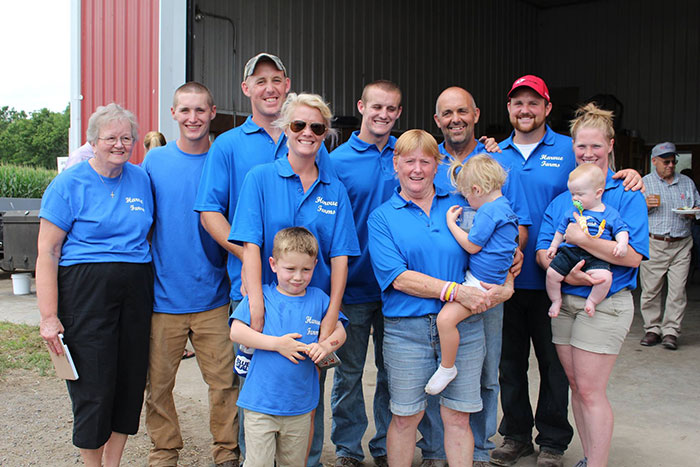
The Hardesty Family, hosts of Virginia Dairy Expo
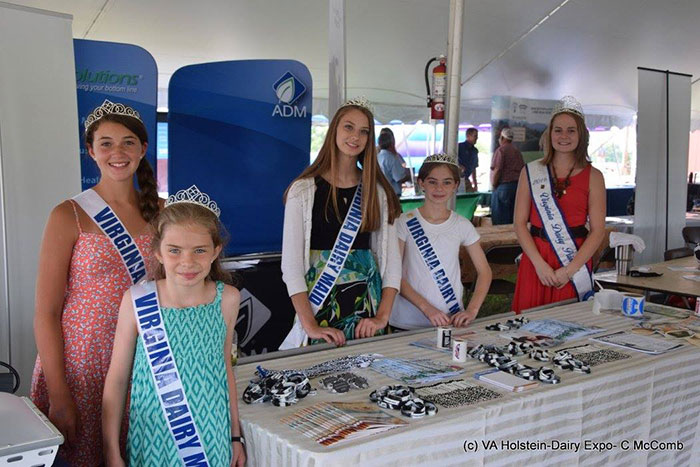
The Virginia Dairy Princess and their booth
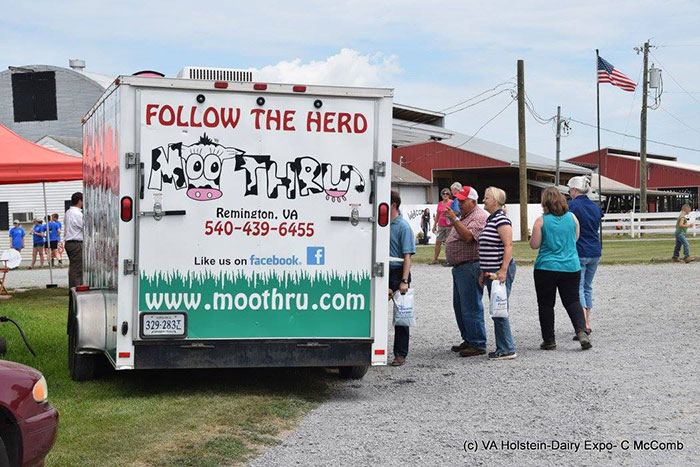
Moo-Thru serving Ice Cream
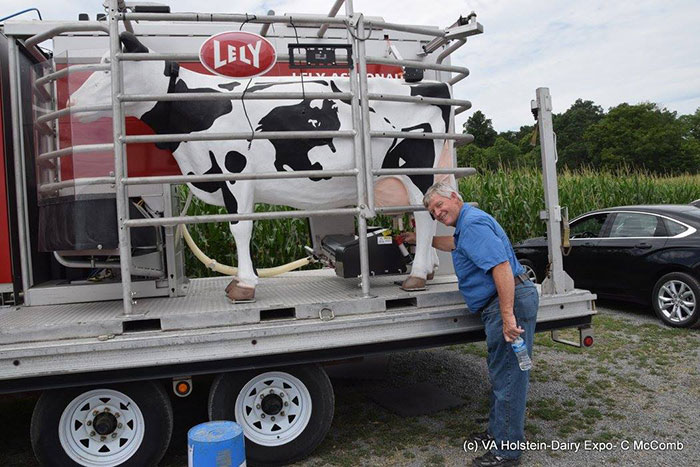
James Cook, candidate for National director from VA checks out display
The 44th Virginia Sale of Stars was held on August 5, 2016
Many of the consignments were from the Cows of the Century Contest.
Thanks to everyone who helped make the 44th Sale of Stars a huge success!
Sale topper was lot # 13 at $9000.00 consigned by Cool Lawn Farm and purchased by Denver Syndicate % Les McCracken, Wis. the calf was sired by Denver X Supersire X East View Love LadyFamily and carried a genomic index of 2677. The sale averaged $2824 on 91 lots.
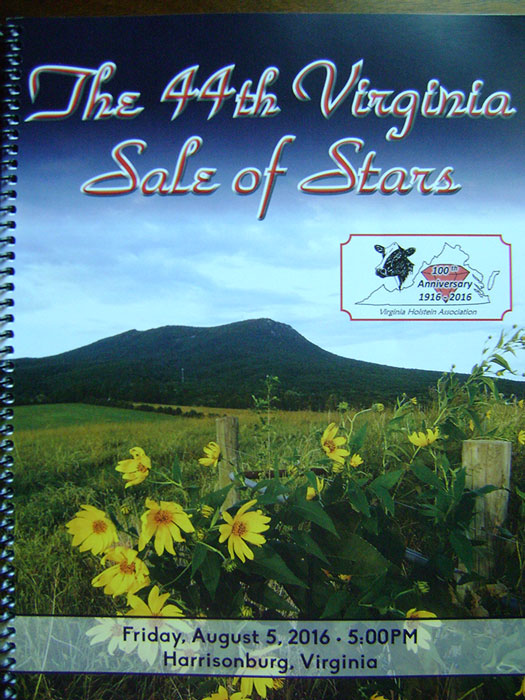
Sale Catalog
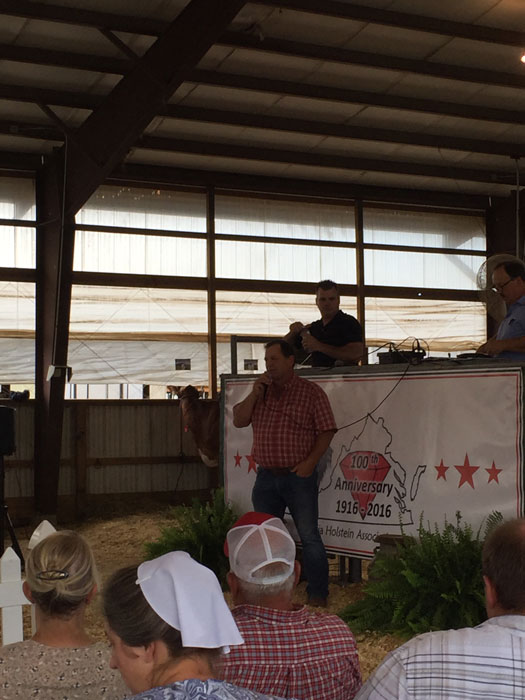
Welcome by Sale Chairman Randy Inman
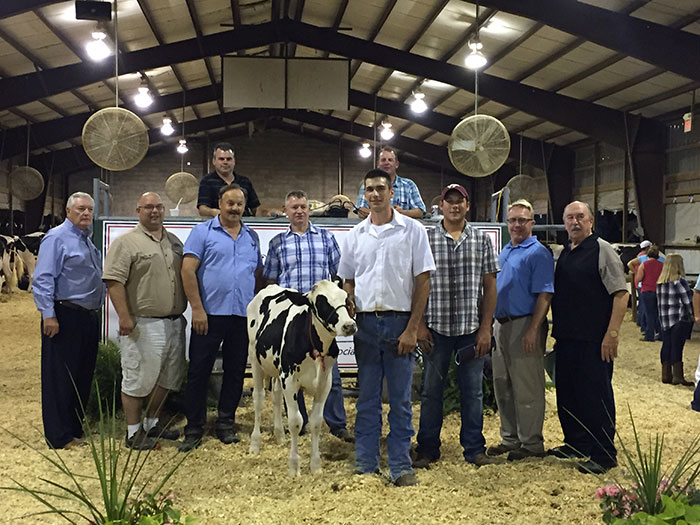
Top Selling Animal
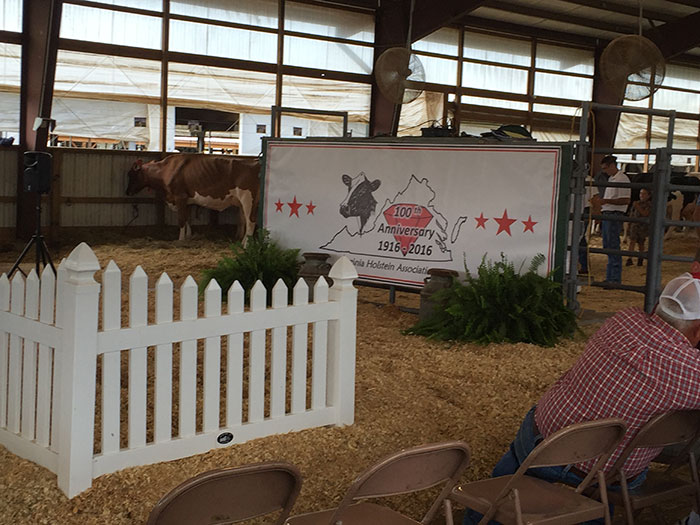
Sale Ring as sale began
Virginia Show on August 6, 2016
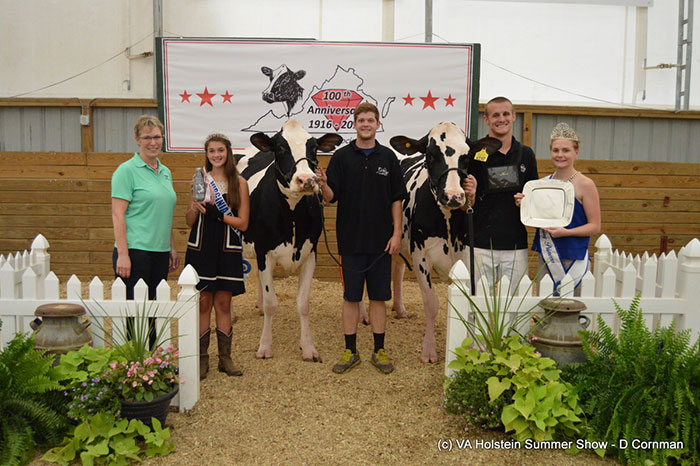
Judge Katharine Knowlton, Va. Dairy Maid Regan Jackson, Reserve Grand Champion--Trevor Holdridge w/ Heiz-Acres Windbrook Fiona(Sr. 3yr old), Grand champion--shown by Davey Hardesty, exhibited by Matthew Hardesty w/ Harvue Shottle Emma-ET(2 Yr old Futurity), Va Dairy Princess Marlaina Johnson.
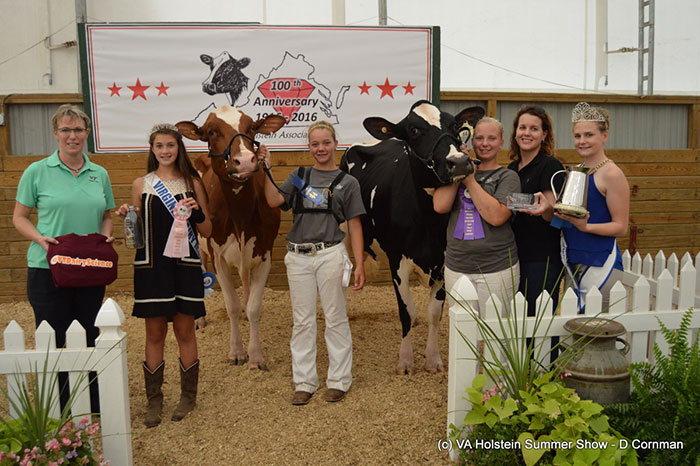
Judge Knowlton, Va Dairy Maid Regan Jackson, Reserve Grand champion Youth--Madison Swoope w/ St.Jacog Ftsy Velvet-Red-ET(Sr.3yr old), Grand Champion Youth --Kelly Callender w/ Walkup Windhammer Flora, Sponsor Kristy McComb, Va, Dairy Princess Marlaina Johnson
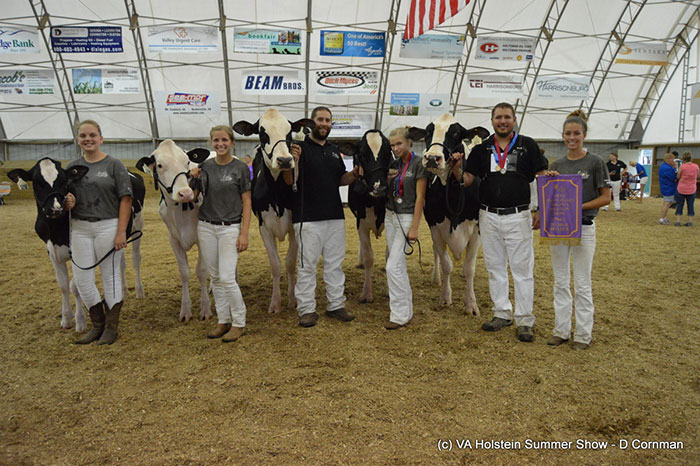
Premier Breeder-- Eastview Farm
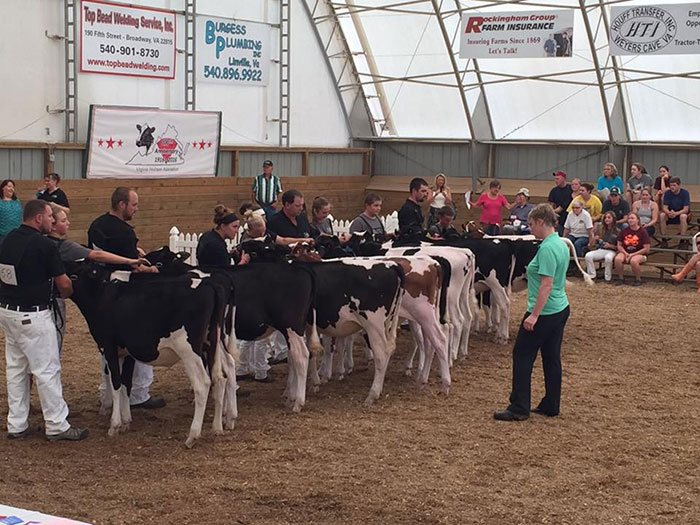
Judge Knowlton judging a class of heifers
100th Anniversary Banquet and Annual Membership Meeting
November 18 and 19, 2016
100th Anniversary Banquet and Annual Membership Meeting
November 18 and 19, 2016
Stonewall Jackson Hotel and Conference Center
24 South Market Street Staunton, VA 24401
CLICK HERE to download a pdf of the VA Annual Membership Meeting 2 page ad.
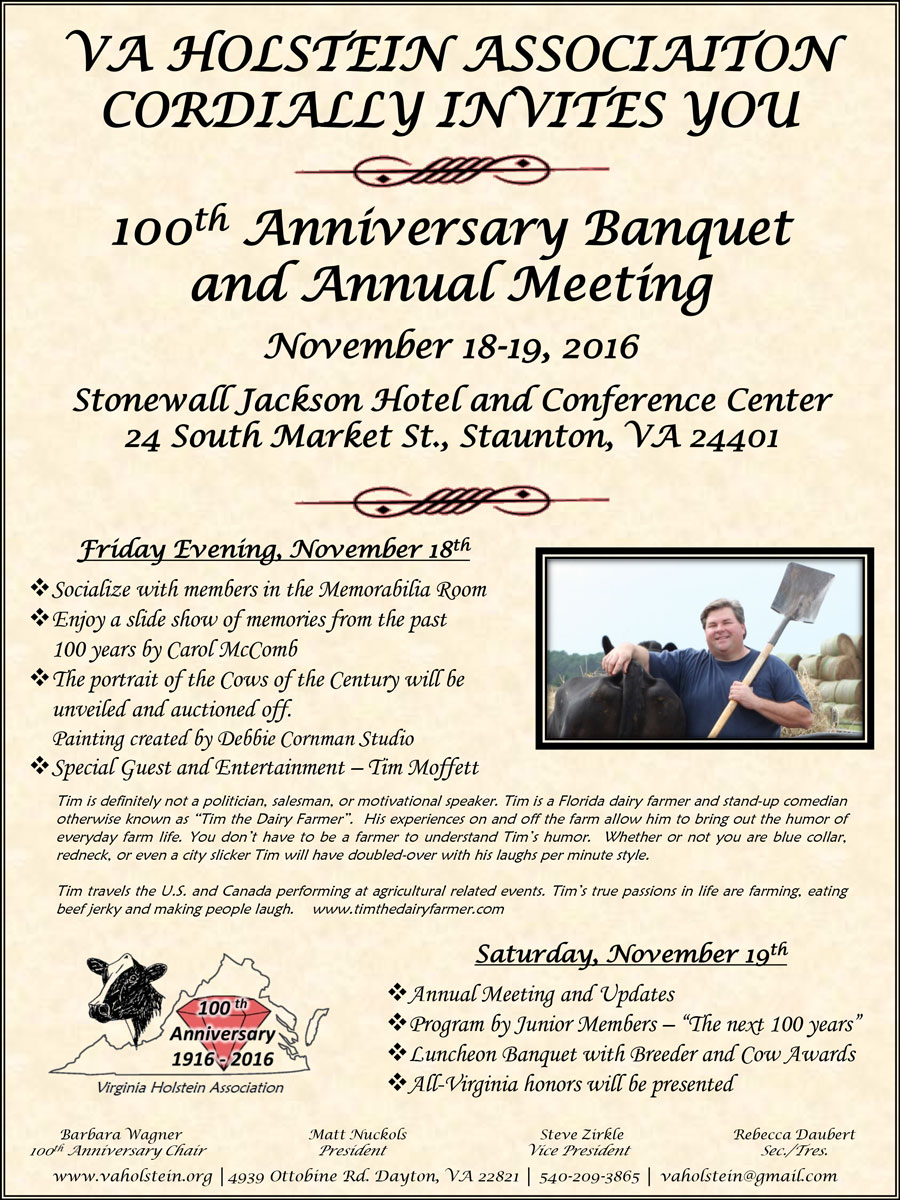
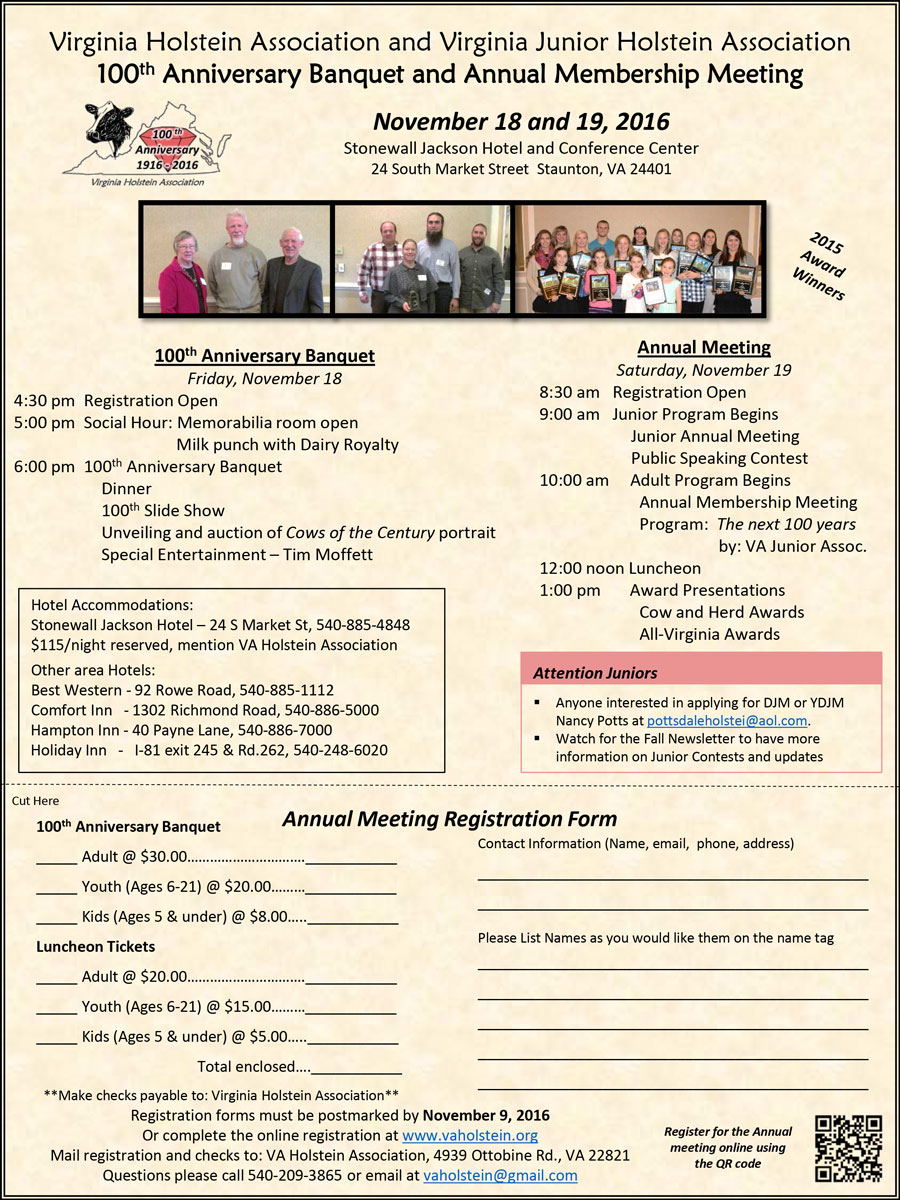
Virginia Farm Histories
Tradition and History Help Keep VA Holstein Strong Over the 100 Years!
This is a collection of stories gathered for the 100th Annivrsary of the Virginia Holstein Association.
CLICK HERE to download a pdf of the Virginia Farm Histories mentioned below.
BURNLEY FARM
Introduction to Burnley Farm
Taken from the 1967 Field Day Brochure
Burnley Farm is located in the Green Springs Valley of Louisa County in the central part of Virginia along US Highway 15. It is here that Lafayette camped during the Revoluntionary War. Burnley is also reported to be one of the spots that Stonewall Jackson camped during the War Between the States. One of the oldest trees on the corner of the property is supposed to have been used to hang several Yankee spies.
Burnley received its name from the owner Mr. Joe Morris who was engaged to a young lady whose last name was Burnley and he named the farm for her. At the last minute, the lady changed her mind but Mr. Morris did not change the name and never married.
Burnley was purchased by Mr. G.E. Fisher ( Mr. R.J. Fisher’s father) in 1919. In 1967, the farm consisted of 884 acres of crops and woodland. The original dairy herd was started in 1925 of grade Holsteins, Guernseys and Jerseys. The first registered Holsteins were purchased in 1925 from Mr. W.O. Perkins of Buckner, Va. At one time, about 20% of the herd traced back to one cow Lady Snowflake Buttermaid 522044 purchased from Mr. Perkins. The real nucleus of the herd was purchased at the State Holstein Consignment Sale in Orange, Va. in 1926.
Early sires used at Burnley came from Rosni Farm and Meadow Farm in Orange, Va. A few home sires were used from time to time. Burnley was one of the early users of artificial breeding.
The herd started using DHIA in 1925 and continued until 1952. They returned to testing in 1957 and went to DHIR in 1960. During those times they were recognized by the National Dairy Association with high herd production.
The original barn was built in 1920 and was converted to a stanchion in 1925. It was extended in 1928 to be able to milk more cows. This barn was used until 1953 when a 4 stall parlor and a tramp shed was built. Four more stalls were added on the opposite side in 1963. The automatic silage feeder was built in 1960. The tramp shed was converted to a free stall barn in 1964. On January 19, 1966 a fire destroyed everything except the parlor and automatic feeder. New facilities were built the same year.
Burnley Farm has earned the Progressive Breeder Award, developed Gold Medal Dams, and a Silver Medal Sire. Many cows have been consigned to State Holstein Consignment Sales.
The Fisher Family & Burnley Farm Now
My grandfather R.J. Fisher, my uncle Jennings, and my father, George, operated Burnley Farm, Inc. when we hosted the Holstein Field Day back in 1967. I remember the day that the picture was taken. It was no small feat to have gotten all seven cousins, along with the calves, cleaned up and posed long enough to get a cover picture!
George (G.E.) Fisher, my father, was known for having a superb eye for dairy cattle. He was part of a group of breeders in the state who selected Round Oak Rag Apple Elevation, and brought this great bull into stud at Select Sires. We used Elevation with much success; we bred a few Excellent and Very Good daughters that went on to do very well for other Holstein breeders. We used Select Sires for most of our semen purchases.
As all dairy producers know, the dairy industry moves boldly on. From the 1970’s through the present, we enjoyed good times, along with dealing with many changes and tough decisions. My uncle Jennings, and his family, left the farm in 1970. The loss of my grandparents (R.J. Fisher in 1981 & Ophelia in 1991), as well as the difficult nature of the business, weighed heavily on us at times. My parents, Jane and G.E. Fisher, were hard working and supportive the entire time as their 3 sons—Terry, David, and Rusty—transitioned into running the farming operation. With time, as on most farms, Burnley Farm saw many changes. Our families grew, and in the late 1980’s, Terry and his wife Susan left the farm to pursue other interests and raise their family. They have two daughters, and reside in Pennsylvania. David and Mary Scott assumed the responsibilities of running the dairy and milking cows. They also have two children, a daughter, Laura, and a son, Randy, who both grew up on the farm, helped with farm chores, and showed their own dairy cattle in 4-H. After Laura completed her degree in Dairy Science at Virginia Tech, she returned to Burnley Farm to help manage the herd. Rusty, along with his wife, Katie, was responsible for the cropping, and the maintenance of the equipment. They have four children -- three daughters and a son.
A computer milking and feeding system was installed in the late 1980’s. As with all aspects of farming operations, the system was upgraded several times to keep up with constantly evolving technology. During the 80’s – the milking herd made the list of Top 100 in The Virginia Dairyman a number of times.
At one point, our herd size increased to an all-time high of 180 milk cows. We hosted many farm tours and seminars for elementary school children and 4-H groups, and were instrumental in organizing the annual Louisa Dairy Day for over 30 years. We produced a State Fair Champion from one of our foundation cow families. And David and Mary Scott were chosen as Young Dairymen Ambassadors for Dairymen, Inc. in 1990.
As time went on, and as the margins in dairy farming continued to shrink, we struggled to find ways to become more efficient, as have most dairies. Eventually, we were faced with a very difficult and emotional decision of whether to make further sacrifices to continue dairying, or switch to another source of livelihood within the agricultural industry. During 2013-2014, the choice was made to switch to beef cattle production, and cropping. The core of the milking herd was sold to a grazing dairy in Florida. And the rest of the cattle went to a registered dairy herd in PA. Rusty took on full-time employment at a local nursery as shop foreman. David now has the primary responsibility of the operation and management of Burnley Farm, after the recent restructuring. Jane and G.E. still help out around the farm and are doing well.
We have managed to continue farming without selling off any of the original 880 acres of farmland. David manages the 100 head beef cow-calf operation. The cattle are rotationally grazed on approximately 330 acres, including 170 acres of Max Q Fescue. The rest of the pastures consist of K-31 fescue, and several good stands of orchard grass and clover. Currently, the herd primarily calves in the fall, but we are working to expand our numbers until we can manage a sizable spring calving group, too. We have acquired several registered Angus cows, and hope to merchandize from them eventually. We also raise 260 acres of soybeans as a cash crop to be sold in the fall. Additional acreage is in hay land and pine trees.
We thank you for allowing us the opportunity to give you an update on how things are going at Burnley Farm, Inc. Although we are no longer dairying, we are thankful that we have ultimately been able to continue doing what we love—farming.
We wish those of you who still milk cows and breed quality Holstein cattle the best of luck and prosperity on your farms.
Submitted by David L. Fisher
OAKMULGEE DAIRY

Pictured left to right, back row, Brandon Moyer, Jeremy Moyer, Larkin Moyer, Front Row,, Damon Moyer, Charles Moyer. This includes the members of the family that work at Oakmulgee Dairy.
The Story of Oakmulgee Dairy
Oakmulgee Dairy Farm is located on the Appomattox River in northern Amelia County, Virginia. In 1895, Oliver Moyer moved to Oakmulgee Farm from the sand hills of Wood Lake, Nebraska. He left where he homesteaded because of drought and cold winters, and picked Virginia because of the land price and warmer climate. The original house, built in 1896 by Oliver Moyer, is still in the center of the farm today.
Oliver originally planted orchards and tobacco. Tobacco was the main crop from 1897 to 1903 while the orchards matured. In 1903, a cannery was built so vegetables and fruit from the orchards could be sold in nearby stores. In 1908, Oliver bought several grade Guernsey cows to feed the leftovers from the cannery.
In 1914, a dairy barn was built and Oakmulgee started shipping milk in cans. The cans were first taken 12 miles by horse drawn wagon to the nearest railroad stop and then shipped by rail to Richmond. Grade A raw milk, butter and cream were also sold in nearby stores around Richmond under the Oakmulgee name in glass bottles.
In 1919, Oliver’s sons, Jake and Charles Sr., became owners and were interested in growing a registered herd. The first registered Holsteins were bought in 1920, and the entire herd was registered by 1928. In 1923, Oakmulgee started DHIA testing, which is still done today.
Oliver Moyer died in 1931, Jake left the dairy to be a DHIA tester and Charles Sr. left an extension job to run the farm full time. In 1951, Charles Jr., the youngest of 3 brothers, became a partner with his father at the dairy. In 1956, Oakmulgee was one of the first dairies in Virginia to buy a bulk tank. A few years later, Oakmulgee had a cow make the state butterfat record of 1000 lbs.
Charles Jr. began running the farm at the age of 37, after Charles Sr. passed away due to a farm accident. Oakmulgee has not purchased cows since the 1950’s, all expansion has come from internal herd growth. Throughout the years, Oakmulgee participated in both state and national sales and has sold several excellent cows to California. Charles Jr. had four children, Larkin, Charlene, Damon and Darrell. Larkin and Damon returned to the farm after earning Dairy Science degrees from Virginia Tech. At that time, the parlor was upgraded to a double 8 herringbone and several years later land become available for purchase to double the crop acreage.
Larkin is the current herd manager and has grown the herd to 300 registered Holsteins. The parlor was updated to a double 12 parallel in 2004, and freestall barns have been added four times since then. Larkin’s two sons, Jeremy and Brandon, both returned to the dairy after graduating from Virginia Tech in 2004 and 2011. Oakmulgee added pedometers and sort gates four years ago which has increased heat detection and made AI easier. The farm is now operated by three generations of Moyers: Charles, Larkin, Damon, Jeremy and Brandon.
Oakmulgee Dairy is one of the oldest continuously operating dairies in Virginia and has been producing milk for over 100 years. As Charles Sr. often said, “If you take care of the cows, they will take care of you.” Although there have been many changes over the years, much about the core of Oakmulgee Dairy has stayed the same. Some of the highlights of these years have been sharing ideas and friendships with other Holstein breeders. It is a great honor to be a part of a community of fellow dairy producers.
RICHDALE DAIRY
Richdale Dairy has Rich Tradition & History
by Dr. Andrew Overbay, Senior Extension Agent, Smyth County, VA
I took the opportunity to write this article to go back in time a bit myself. As a young Extension Agent housed in Wythe County, I journeyed out to Richdale Dairy Farm many times over the course of my early start as the dairy agent for southwestern Virginia. Going back down Richdale Road, I was struck with how a few years can make a huge difference in the physical features of a farm. I was thrilled to see new houses (owned by young farmers!) and new barns had been erected over the 11 years since I served the county.
When I was dairy agent, one of my favorite things to do was to write human interest pieces on the dairy producers of the area, so when I was contacted to do an article on the Crowgey family, it was a blessed return to a time gone by…. on many levels. When I arrived at the farm, I was greeted by Eric and his son Aaron who were busy picking fresh sweet corn for the Farmer’s Market. After explaining why I was there, I ran across another sign that times had changed; Aaron told me that most of the information I was seeking was neatly packaged on their farm’s Facebook page. Yep, the modern age was staring an old Extension Agent in the face (or Facebook in this instance!).
The following is the Richdale story taken from Facebook and the personal story of Leonard Joe Crowgey Sr. that he penned to be included in the booklet serving as the program for the Virginia Holstein Field Day held at the farm on Saturday, August 8, 1953.
Richdale Farm is located in Wytheville, VA and was founded by Henry John Crowgey from Cornwall England, in November 1876, when he purchased 253 acres. It was operated as a general livestock and home to 9 brothers. In the fall of 1929, Leonard J. Crowgey, one of the nine brothers, purchased Mr. Harold Searles herd of 21 registered Holstein cows from Wisconsin. According to L. Joe Crowgey Sr., in the summer of 1920, he was working as a milk tester during summer vacation at Grahamholm Farm in Rochester, Minnesota where Mr. Searles was the manager. Mr. Searles had developed his herd from the Grahamholm stock. Among the animals purchased was a bull, Grahamholm Piebe Charmette King.
Beginning as a seller of manufactured grade milk, Joe Sr. soon began shipping grade A milk into the West Virginia market, a market he continued to service at the time of the 1953 Field Day. At the time he leased the farm from his parents and continued in that pathway until his parents’ death. The estate was settled and Joe, Sr. bought the farm at public auction in 1942. The herd was sold down in 1942 to put a down payment on the farm and again in 1947 to purchase additional land. This began a trend of annual sales of animals and each year a considerable number of animals, both bulls and females were sold, many to Virginia State Sales. Joe Sr. wrote, “these cattle have gone to Pennsylvania, Maryland, West Virginia, North Carolina, Ohio, Georgia and Tennessee as well as into most every section of Virginia. Our bulls have been used in artificial breeding associations in Pennsylvania, Virginia, Tennessee, and North Carolina.”
“In the early development of the herd,” Joe, Sr. continued, “our first bull Grahamholm Piebe Charmette King was developed into one of the early DHIA proved bulls in the state to have daughters average above 400 pounds of fat. In 1936, the herd was composed mostly of his daughters and granddaughters. We sold him to Curles Neck Farm in Richmond. Later we bought him back and used him again in the herd.”
Other bulls soon followed. Ormsby Sensation Lad Colantha, a son of Ormsby Sensation 54th out of a daughter of “Old Piebe.” Joe, Sr. noted that while this bull’s daughters did not average as high, he sired some of the “best cows we had” including the state record cow for milk and fat, Lady Segis Colantha Sensation. She was a cow far ahead of her time as she made 25, 633 pounds of milk and 923 pounds of fat! Joe, Sr. noted that a Beltsville bull was also used and while his daughters averaged 419 pounds of fat, they were not as well made and thus were not as desired as daughters of other bulls.
Richdale was also breeding and using some of their own bulls including one from the “Wisconsin Pinky” family. Joe. Sr. had been looking for a herd sire when he was advised by Mr. Glen Householder to get a son of Wisconsin Admiral Burke Lad. He purchased Weber Admiral Burke Fobes form Utah Industrial School, in Ogden Utah as a calf. This calf was out of Weber Pinky Rosalind, a good producing cow with “quite a show record. She had an exceptionally good udder,” recalled Joe, Sr.
Burke proved to be a gold strike…literally. The bull fit into the herd perfectly and by 1953, all but three animals traced their roots back to him. The bull met the requirements for a Gold Medal Sire of the Holstein-Friesian Association of America and one of his sons that was used at VPI (now Virginia Tech) was a Silver Medal Production Sire. “Unfortunately,” Joe Sr. wrote, “we sold many daughters of the Burke bull before we knew how great a bull he was!”
Ancestors of the bull and the females of Richdale Farm found their way around the state, three of which were owned jointly by Hollins College and Mr. Harold Craun. One of those bulls was a son of the top selling animal at the 1953 National Holstein Sale.
Back at the home farm, in 1952, thirty-two cows were in the milking herd averaging 13,349 pounds of milk and 527 pounds of fat. Thirteen cows in the herd were Excellent or Very Good. In 1956, L. Joe Crowgey, Jr. returned to the farm after 4 years in the United States Air Force and 4 years at Virginia Polytechnic Institute. He saw to the steady expansion of the herd with the introduction of TMR in the mid 1970’s. He also served as one of the founding members of Virginia Genetics.
In 1969, L. Joe Jr. and his wife Jane acquired the farm from Joe Sr.’s estate. At that point, the farm reached its 500-acre present size. In June of 1982, Eric returned to the farm after graduating from four years at Virginia Tech, where he met his wife Lisa. The registered herd continued to grow to 150 dairy cows and added 60 acres of additional rented land. With the conventional dairy business in a gradual decline, they added pumpkins in 1999, a flock of Katahdin Hair Sheep in 2004, and sweet corn in 2008.
More “super cows” followed in the 1980s. LJC Noble Conductor Mars, bred by the Crowgeys and owned by Cardinal Holsteins was purchased by Bayville Holsteins. Noble is listed among Virginia Holsteins “Cows of the Century.”
The Crowgeys continued in the registered Holstein business until 2006, when the herd was sold to a registered breeder in Florida. The Seasonal Grazing Dairy was hatched when Aaron wanted to return to the farm after graduating from The University of Tennessee in 2009. Ideas became reality when they purchased 80 Jersey Holstein Crossbred heifers in the spring of 2009 and a new dairy barn was completed in April 2010. Currently the Crowgeys milk 112 Jersey cross cows and have 400 Katahdin Ewes plus lambs, 15 head of beef cows, 12 acres of pumpkins, fall produce and 1 acre of sweet corn.
VIRGINIA TECH DAIRY
Breeding Registered Holsteins Since 1895
By Chuck Miller, retired Dairy Center Superintendent
In 1872, the Virginia Polytechnic Institute and State University (VPI) was founded in Blacksburg, VA. The Morrill Land Grant Act of 1862 had provided for the funding to establish schools in each state to teach agriculture, military tactics, the mechanical arts, and classical studies. Known at its founding as the Virginia Agricultural and Mechanical College (VAMC), it was located on the 5 acre site of the former Preston and Olin Institute. The Board of Visitors (BOV) purchased from Colonel Robert T. Preston, a portion of his estate known as “Solitude” for $85 an acre, for use as the college farm. Located a ¼ mile from the Institute, it included the mansion, principal farm buildings, and 250 acres of land. Today, the mansion located near the Duck Pond is the oldest structure still standing on the Virginia Tech (VT) campus. Known as “Solitude” it was restored in 2011, having served as faculty housing, a student infirmary, offices, and classroom space.
Some of the 132 young men enrolled in the first session at VAMC began working on the college farm in the late spring of 1873. In the first annual report of the VAMC to the General Assembly, manual labor in the stables, dairy, orchards, and gardens provided practical work experience for the students to support themselves. Among the stock donated to the college farm were a thorough-bred Durham bull, 3 thorough-bred Durham heifers, and one Alderney bull. Durham cattle, also known as Shorthorns, were the breed of choice in the mid-1800s since they were good producers of both milk and beef. The Alderney breed had developed from the Guernsey breed.
The annual report of the fifth collegiate year of 1876-77 included a Report of Farmer and a Committee of the Board of Visitors on the Farm. Students provided a large part of the labor on the farm gaining experience in horticulture, animal husbandry, and crops. Receipts for the farm showed $264.00 received for milk and pasturage. The farm had sheep, swine, horses, and a herd of 21 Shorthorn cattle including 9 purebred head – 2 bulls, 4 cows, and 3 heifers. These were the early years of the Virginia Tech dairy.
The Virginia Agricultural Experiment Station (VAES) was established by the state on the VAMC campus in 1886 to conduct research in agricultural science. The VAES reported its findings to Virginia farmers and consumers as useful information in printed bulletins and demonstration exhibits at fairs. This work was later done by the Virginia Cooperative Extension (VCE) begun in 1914. The college, VAES, and VCE have shared the campus agricultural buildings and the barns, animals, and cropland of the college farm to teach students, to do research, and to inform Virginians about agriculture. The first registered Holstein-Friesian bred by the dairy was Neva Artis Clothilde (40635). Born on October 16, 1895, her sire was Raeburn (22602), owned by VPI and bred by H. W. Austin of Woodstown, New Jersey, and her dam was Eva Artis Clothilde (33679) owned by VPI and bred by H. W. Austin of Woodstown, New Jersey as recorded in H-F Herd Book Volume XII and XV. Her six daughters owned and bred by VPI were Artis Kaska (47726) born March 2, 1898, Sinfi Artis Clothilde (49876) born April 20, 1899, Gretel Artis (62950) born November 3, 1901, Iberia (68778) born December 26, 1903, Rowena Artis (76688) born November 27, 1904, and Caltha De Kol (86842) born December 10, 1905. This first purebred breeding by VPI was the beginning of the dairy’s registered Holstein herd that has been continuous for 121 years.
The foundation stock of the VPI herd began with the purchase of Eva Artis Clothilde (33679), the dam of the first registered Holstein bred by VPI. She was prolific at producing quality heifer calves. Individual lactation records for 1904-1906, show four daughters averaging 6245.6 lbs of milk, six granddaughters averaging 6102.3 lbs of milk, and two great-granddaughters averaging 5236.2 lbs of milk. She, herself averaged 6041.1 lbs of milk. In July 1907, VAES Bulletin No. 170 Studies in Milk and Butter Production, stated, “these figures are an evidence of hereditary prepotency of the milk giving instinct which can be transmitted from generation to generation. A cow of this type is invaluable to dairymen.” The value of good record keeping and careful selection were also stressed in this report to Virginia dairy farmers just beginning to build herds with purebred bloodlines.
In 1908, Hygeia Veeman Butter Boy (43697) a new herd sire was bought from the well known Hygeia Herd owned by Dr. W. F. Carter of Crozet, VA. Born October 6, 1908, he had been bred by Stevens Brothers-Hastings Co. in Lacona, NY. His dam, Jessie Veeman A (36579), was never beaten in the show ring, and was championship aged cow at the New York State Fair in 1904. This bull’s sire was De Kol 2d’s Butter Boy 3d (23260), a Century Sire, and son of De Kol 2d (734), foundation cow of the De Kol family. As herd sire, he had 12 daughters – five 2 year olds, one 3 year old, and three 4 year olds – that had records averaging 668 lbs butter in a year. In 1920, his granddaughter VPI Veeman Korndyke De Kol (60633) bred, developed, and owned by VPI, set a Virginia State record for both milk and butter in her class as a senior 2 year old, of 844.2 lbs butter from 20696 lbs milk.
In 1913, Buckeye De Kol Pauline 2D (94346) bred and owned by VPI, had a yearly record at 6 years 2 months of 1159.5 lbs butter from 20784 lbs milk, a world record for cows owned by experiment stations and colleges, and a world record for cows, all breeds, developed south of the Mason Dixon Line. Her lineage is also from the grand cow De Kol 2d (734). Her sire, Homestead Crown Prince De Kol (25865) was the grandson of De Kol 2d’s Paul De Kol, the son of De Kol 2d (734). The line continued when her son VPI Buckeye Pauline Korndyke (193742) became herd sire in 1919. As the commercial dairy industry expanded due to increased demand for milk in cities, the Holstein-Friesian with its ability to produce a large quantity of milk became the breed desired by Virginia dairymen.
Two later milestones in dairy cattle breeding occurred at the VPI dairy. The first Holstein calf born in Virginia from artificial insemination was a Holstein, Virginia Test Tube 2165078, born October 17, 1939 at VPI. Then, in 1954, Professor Paul Reaves’ class in A. I. did research on frozen semen using dry ice and alcohol. The first registered Holstein calf born in Virginia from the use of frozen semen was VPI Jessie Katrinka Defrost 4098698, born August 13, 1955. In addition to Holsteins, over the years the VPI dairy has had herds of Guernseys, Jerseys, Ayrshires, and Brown Swiss. The dairy herd today has 250 milking cows for teaching and research, with 60% Holsteins and 40% Jerseys. Students continue to provide a large portion of the labor at the dairy.
History of Barn Locations
When the college farm began in 1873, all of the animals, livestock, and dairy herd were housed in the old barns and pastures of the “Solitude” estate. Built before the Civil War, they were located in the area where Price Hall stands today. Repairs and additions were made as the farm operation expanded.
In the summer of 1893 a creamery and cheese factory were built. It stood on what is today the Drill Field, directly in front of Price Hall. The creamery processed milk and cream from the dairy into dairy products for the mess hall. Experiments were done in how to ship milk and cream long distances and how to improve dairy products. The results of these and other studies helped expand the milk market of the Virginia dairy farmer.
In 1899, a new modern two story hillside barn was completed. With room for 128 animals, it housed all of the cows, bulls, steers, young stock, work horses and mules of the college farm. This large facility had a hay and grain barn, two wings for cattle, an open court between the wings, a milk room, two 200 ton silos, and four manure carriers. A hog house, a sheep barn, and large stock feeding barn for 120 head of beef cattle were built over the next few years. By 1905, all of the college farm animals had moved to these model barns located in the area where Ambler Johnston Hall stands today. Students milking at the dairy were paid 2 ½ cents per cow per milking in 1916. Later improvements to the dairy barn included: a shed with concrete floor, new silos, reconfiguring stalls for research, and a milking parlor with a pipeline milker built in the 1930’s. The dairy herd remained at this location until 1960.
By 1906, the old barns of the “Solitude” estate had been torn down and the foundations laid for a new Agricultural Hall on the site. Later named Price Hall, it opened in January 1907. The creamery moved into the first floor with state of the art operations – a commercial creamery plant, a testing room, a room for pasteurization and sterilizing, and a refrigeration plant with cold storage. The dairy and local dairy farms sold milk to the creamery where students learned how to manufacture dairy products. The creamery furnished the dining halls with milk, butter, cheese, and ice cream into the late 1960’s. Its dairy products were also marketed in Blacksburg, Roanoke, Norfolk, and Bluefield, WV. The creamery moved to the new Dairy Husbandry building, later known as Saunders Hall, in 1931.
In 1950, a new dairy barn was built ¾ mile south of the old barns. It was a two-story, 60 cow tie-stall/stanchion barn with a mow on the second floor for hay storage, and silos. This was the first building on the site of the VT Dairy Center located on Southgate Drive.
By 1960, a new freestall barn, a loose housing barn, two milking parlors, a calf barn, bull barn, and heifer barn had been built. The pavilion, later named the Etgen Pavilion was built in 1963. All dairy animals were now housed at the Dairy Center. The old barns were torn down to make way for the construction of Ambler Johnston Hall, Cassell Coliseum, and other campus buildings. Construction of Route 460 around Blacksburg in 1968, placed the Dairy Center barns inside the bypass and on the Southgate exit to campus.
From 1970 to 1990 facilities were added to improve research methods, data collection, and farm operations. Added to the milking parlor were two stalls, a larger bulk tank, automatic cow ID, and computerized milk recording. Freestalls were added to the loose housing barn. The 26 calan doors were installed to measure individual feed intake of cows housed in freestalls. A Data Ranger Feed Cart was added, equipped with computer that weighed feed ingredients, mixed the ration, and recorded the amount fed each animal, feed refused, and net intake per day. A 20 stall bull barn to do extensive research in artificial insemination and a heifer barn equipped to measure feed intake by computer were built. The use of 40 calf hutches improved calf health and growth.
In 2002, the tie-stall/stanchion barn and silos built in 1950 were demolished. Finally able to replace the dairy’s outdated 1960’s era milking parlor and free stall barns, a new facility was built. In July 2004, the milking herd moved into a modern, state of the art, 232 freestall barn with 48 calan doors to measure individual feed intake and a double eight rapid exit milking parlor with milk production and milk component data collection. A commodity barn, manure solids separation, and liquid waste storage facilities were also built.
In 2006, the university administration announced plans to move the Dairy Center to Kentland Farm, acquired in 1987, and located 9 miles from campus. This move was necessary due to the proposed new Route 460 interchange entrance to campus, expansion of the VT Corporate Research Center, and expansion of the VT Montgomery Executive Airport.
In August 2015, the dairy herd moved to the new VT Dairy Science Complex at Kentland Farm. Facilities designed with the latest dairy science technology include a double 12 parallel milking parlor, a 232 freestall barn, a special needs barn, and a calf barn. A 24 stall barn for intensive metabolism research has been funded with construction expected to begin in late 2016.
The long history of the dairy at Virginia Tech has shown that while the needs of a growing dynamic university have prompted the relocation of the barns and animals, the benefit of each move has been the upgrading of the dairy facilities to better serve the mission of the dairy science department.
WALKUP HOLSTEINS
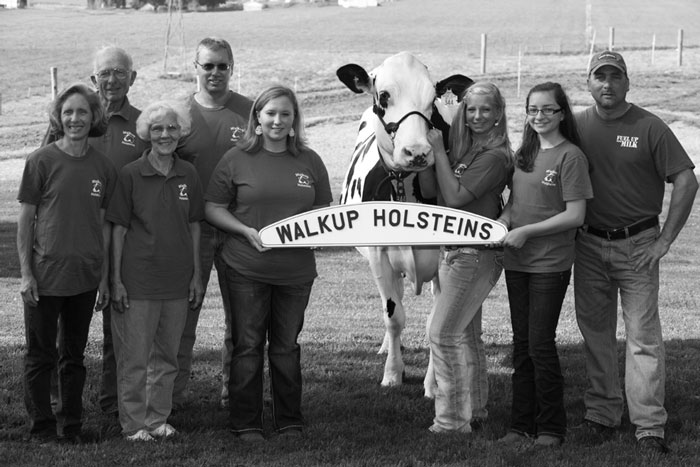
Walkup Holsteins family: (L-R) Teresa Callender, Dan Myers, Charlotte Myers, Donnie Callender, Kristina Callender, Kelly Callender, Anna Myers, D.J. Myers. The cow is Walkup Blitz Trisha 2E-92
Introduction to Walkup Holsteins
Taken from Field Day programs 1940 and 1980
Foundations from the Past, Building for Tomorrow
The decade following the Civil War was one of reconstruction for the battle-scarred South. It was a time of mending bodies, spirits and fences. In the spring of 1877, Jackson Showalter, great, great grandfather of Daniel J. Myers registered his purchase of a farm in the Lick Skillet settlement of Rockingham County, Virginia. This original parcel was the beginning of East View Farm and Walkup Holsteins.
Like many farmers of the period cows were kept for family use. The surplus was sold at local markets. Isadora Showalter, Jackson’s granddaughter married I.D. Myers and they assumed responsibilities of the farm. It is noted that Isadora could drive a four horse team better than any hired man. Besides the field work she had to milk 3 times a day. Her son, Victor, noted that she was “one of the best hand milkers around.”
The lower barn on the farm was built in 1912 and the house was added in 1918. In 1920 the first registered Holsteins were purchased at the Halderman Dispersal in Winchester, Va. In 1921 the first Holstein bull was added to the herd. The herd was put on test in 1926 with averages of 14,409 pounds of milk and 486.6 pounds of fat, the highest in the state.
I.D.’s son, Victor became involved with 4-H dairy projects. His interest included showing and participating in fairs all over the east coast.
In 1939, a new dairy barn, all stone, was built. It was a tie-stall barn for the use of electric milkers. Victor’s wife Margaret noted that they were a definite improvement from hand milking.
In 1940, I.D. Myers and his son Victor, hosted the eighth annual Virginia Holstein Field Day. In 1941, Victor and his wife Margaret assumed operation of the farm. Margaret, also from a dairy farm, was active in the daily operations of the farm. She was on the Board of Directors for the Virginia Holstein Association and later was a DHIA supervisor in Rockingham County.
A small set back occurred when the dairy barn was damaged by flames in1950. The barn was repaired and the farm continued to grow. Both son Dan, and daughter Leann became involved in the farm and projects for their 4-H Work.
Following college Dan married Charlotte Dove. Dan became a school teacher and later an assistant principal but it seemed his heart was at home on the farm. In 1968, Dan and Charlotte assumed full ownership of the farm. They had a philosophy of “getting better before we got bigger”.
With two small children, Teresa and D.J., they were determined to remain a family farm. Charlotte fed the calves and helped with the milking. As the children got older they were expected to help with the chores. Just like his grandfather, I.D. Myers, Dan states that the feeding programs were as important as the breeding to the productivity of the herd. Two 20’X60’ silos were added to the feeding system and a milking parlor was added to the dairy barn with free stalls for the cows. The most recent addition in 1980 was the counter slope heifer barn.
In 1980 the Myers Family once again hosted the Annual Virginia Holstein Field Day.
***Margaret Myers Adams, Dan’s mother, was a pioneer for all women in the Virginia Holstein Association. She was the first woman to serve on the Board of Directors, first woman President of the Shenandoah Valley Holstein Club, first woman to receive the Virginia Holstein Association Meritorious Award and was honored with a lifetime membership in the Virginia Holstein Association. She was always a lady and was a role model for me!
Barbara Wagner, Rilara Holsteins
Walkup Holsteins
By Dan Myers
During my years at Bridgewater College I majored in Mathematics and avoided most of the classes in communications. After resigning from teaching and the job as Assistant Principal at Broadway High School following four years as an employee of Rockingham County Schools, Charlotte and I purchased the home farm. In almost 50 years I have forgotten most of the mathematical theory and am now struggling with the fine art of communication. The following paragraphs are a short history of Walkup Holsteins, LLC.
Jackson and Catherine Showalter purchased the farm in the spring of 1877 with the seven subsequent generations living on the farm.
Our prefix “Walkup” was reserved in 1927 as the “East View” prefix was not available. Our farm was known as East View Farm until Charlotte and I purchased the farm in 1968. At that time we changed the farm name to “Walkup Holsteins” and Walkup has served us well.
I need to share the fact that my mother, Margaret Myers Adams, held the farm together as a single parent until I was able and willing to receive the love of the Holstein cattle and handle the work and management of the operation at that time. We began the process of upgrading the facilities and raising two children, Teresa Callender and D.J. Myers.
With the sale of Shenandoah’s Pride in 2000 our family decided to reinvest those proceeds to modernize and allow us to remain a viable part of the dairy industry. In 1992 Teresa and her husband, Donald Callender and our son D.J. Myers joined us in forming a limited liability partnership under which we operate today.
In 1942 my dad, Victor, extensively showed “Firestone Lyona Boy Louise” and she was selected Honorable Mention All American that year. In 1976, I had the honor, to show “Walkup Charm Iva Judy” and she was selected High Honorable Mention All American that year. In 1978-1982, Teresa was blessed to show the most influential cow ever bred at Walkup Holsteins “Walkup Astronaut Lou Ann”. She was selected Junior All American three times, twice Reserve Junior All American, Once High Honorable Mention Junior All American and twice nominated All American. After 16 years of astronomical achievements, Lou Ann is buried in the yard at Walkup Holsteins.
One of our goals is to breed an All American with the Walkup prefix. We understand the chances are very slim; however the love of quality animals makes the journey almost as rewarding as the destination of an All American. Our present herd average of 23,013 lbs. milk at 4.5%, 1031 lbs. of butterfat, and protein at 3.0%, or 683 lbs. is a work in progress. Our goal is not production, but enough efficient production to maintain a quality of life for our cows and our families. The challenge of economic pressures is making all dairy farms, including ours, prediction of the future impossible.
In conclusion, I want to thank the dairy industry and the Holstein Association of Virginia for allowing Walkup Holsteins to be a part of each of them. And, as I wrote 35 years ago: I will be content if what I have done will be of service to my God, my family, and my country.
Friendship and Holsteins

Friendship and Holsteins
As the celebration of the Virginia Holstein Association’s 100th Anniversary draws to a close may I say “Thank you” for allowing me to renew old friendships through phone calls, emails, planning sessions or requests of help with a particular project.
I truly hope that you have enjoyed reading the stories, histories and memorabilia in all of the publications throughout the year. We had a marvelous day at Harvue for the field day with so many “old friends’ returning to the share the day. The Sale of Stars proved that the Virginia Holstein Association’s Cows of the Century took center stage with many of the pedigrees showing the depth of Virginia breeding. Watching the Summer Show with most everyone wearing the anniversary shirts displayed a unity in our organization. The summer anniversary events were top notch and each committee set the standards high. Well done to each of you!
Belonging to the Virginia Holstein Association has brought many friendships that we would not have had without the sales, shows, conventions, twilight meetings and most of all the dairymen themselves. “Friendship and Holsteins” has been a slogan of the Virginia Holstein Association for many years. So, pardon me for getting personal as I relate some of our experiences of Friendship and Holsteins. Hopefully this will bring back memories of your experiences just because of that one Holstein cow/calf that was consigned to a sale.
During the height of the Elevation and his popularity a group of Virginia Dairymen sent a truck load of Elevation daughters and a few other well-bred animals to the California Galaxie Sale. One of those was a calf sired by Elevation from a little known breeder at that time- Rilara Holsteins. She did not make the headlines because others far out sold her price. However a friendship developed over a period of years between the VanVliets in California and the Wagners. Visits were exchanged from California to Virginia to Texas. Was it the now famous cow (Gr-Dam of Laban) that that calf had become or was it the friendship that had developed between the individuals involved? Many friends were made as a result of that sale consignment.
While on a tour with Select Sires to California, we were introduced to a young couple, Andy and Jean. We were welcomed into their home and once again a friendship developed. Each year at the National Holstein Conventions, we would meet and catchup on their cows and most importantly their children.
As years passed we were at the convention to share in their daughter Patti being named Distinguished Junior Member. And now many of you would recognize her name –Patti Hurtgen.
This true story was related to us when we attended the National Holstein Convention in California in 2009. Lloyd Vierra (Select Sires) had a niece who was thinking of applying to Bridgewater College in Bridgewater, Virginia and the question was asked “Where is Bridgewater, Virginia”? Lloyd responded, “I know, I’ve been there! His niece’s family replied,” We don’t know anyone there”. Lloyd responded again with “I do. My friends the Wagners live there”. Friendship—all because of the Holstein cow!
Many times through the years hauling cows to sales was a joint venture especially the Southeastern Show Window Sale. Farmers took turns each year hauling to the sale. One of those trips included a bred heifer by the name of Ravena. She opened a lot of doors of friendship for Rilara Holsteins. The Johnson Family in North Carolina and Rainey Family in Georgia remain dear friends to us to this day. We can only smile as Supersire makes the headlines as the number one Genomic sire of today. Who would have thought that one consignment could make us friends from the United States to Europe and beyond?
Just sitting around the kitchen table eating fresh Strawberry Shortcake with other Holstein enthusiast can be rewarding. Many times I have been reminded by Horace Backus and George Miller about how much it meant to them to just relax and have fun visiting and talking cows. Why were they there? Probably to select cows for a sale, but they only remember the hospitality and the Strawberry Shortcake!
And how could I forget Mr. George (Edgerton)? He was a friend to all who loved the Holstein cow and a mentor to the youth exhibitors. His advice on how to buy a good Holstein calf/cow was an inspiration to many of the junior members. It was an honor to have owned cows in partnership with him!
I have watched from the sidelines at many sales as friends form syndicates to buy a really good cow when the purchase price was too high for only one to take her home. What memories do you have of Friendship and Holsteins?
My memories will always include you, the members of the Virginia Holstein Association, who have made the last five years of planning the 100th celebration a much easier one because I could call on each of you to help and you responded whole heartily- all because of Friendship and Holsteins!
Barbara Wagner
Chairman, Virginia Holstein Association 100th Anniversary Celebration
© 2016 by Dairy Agenda Today. All rights reserved.
